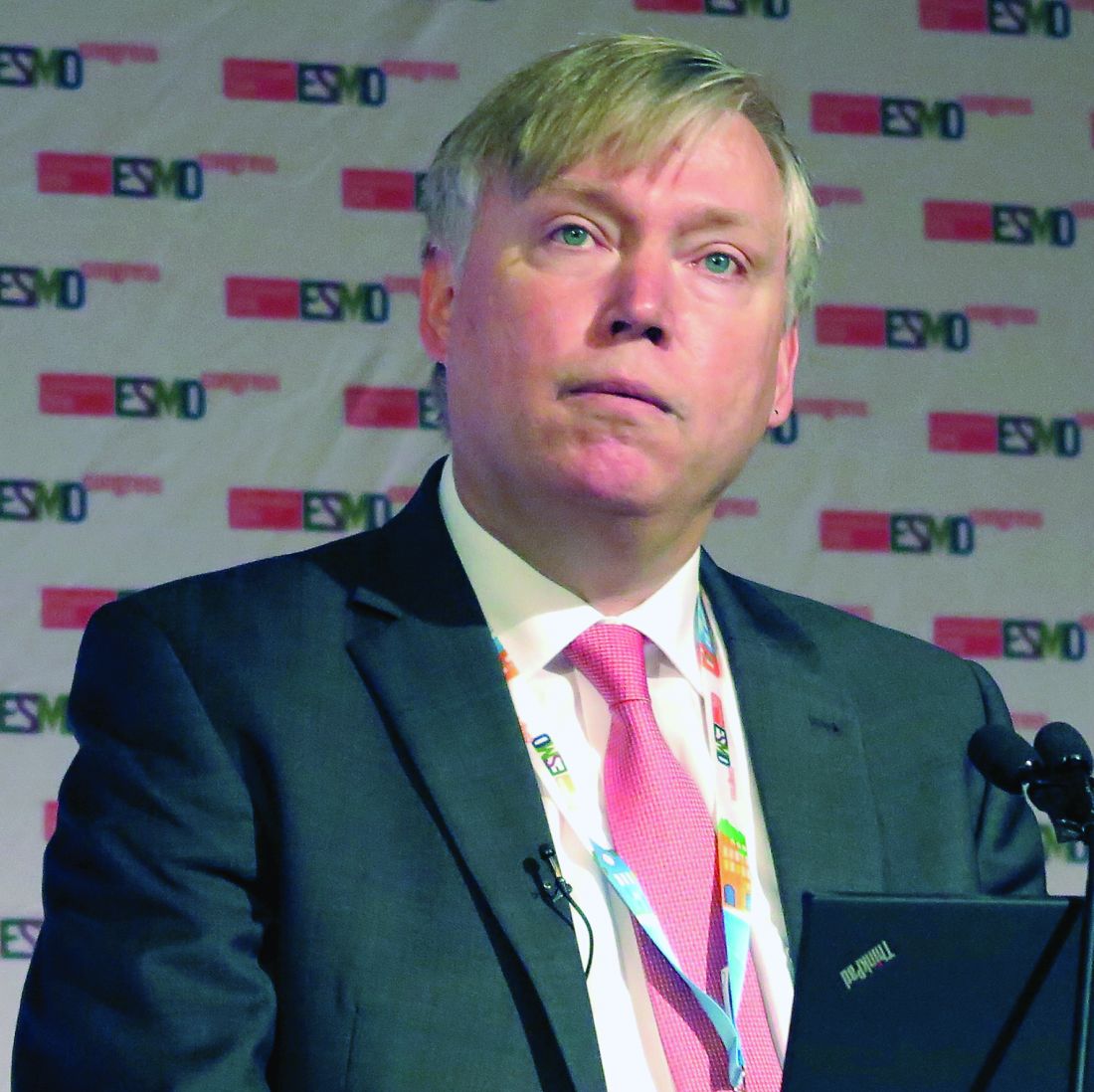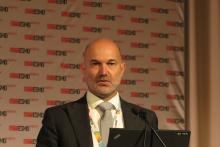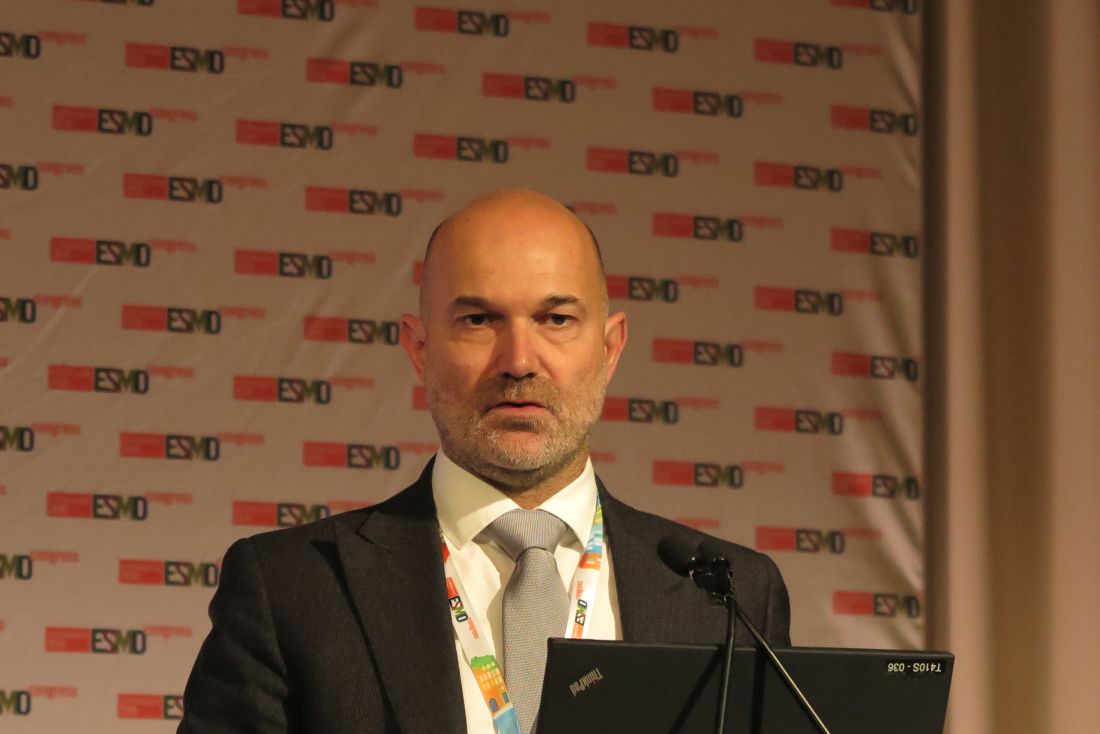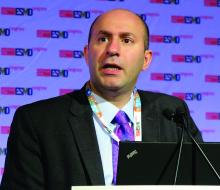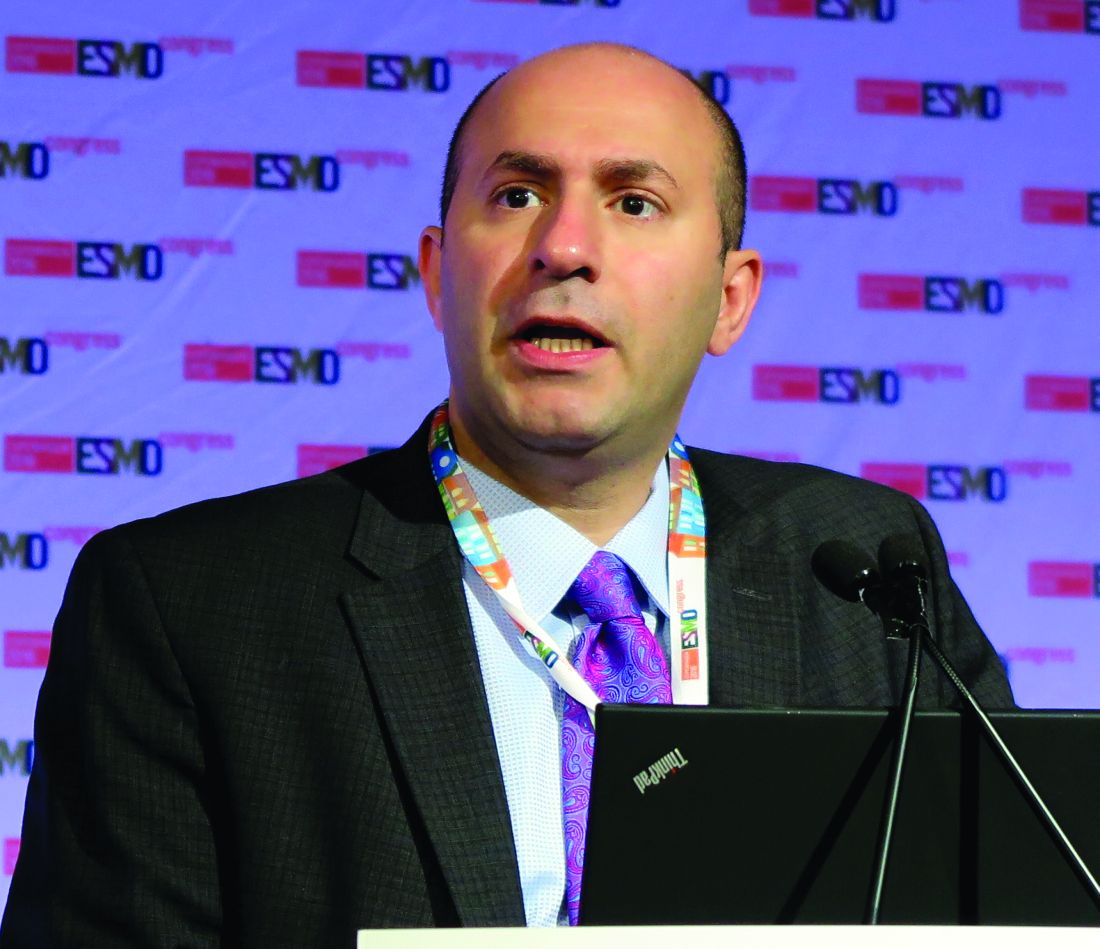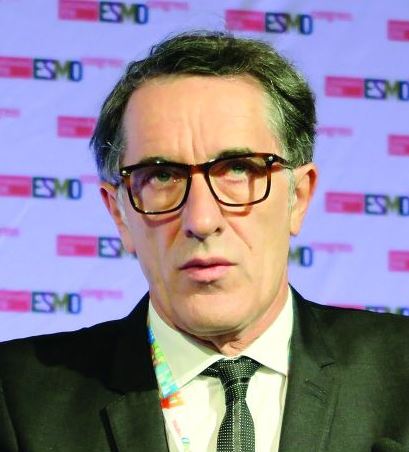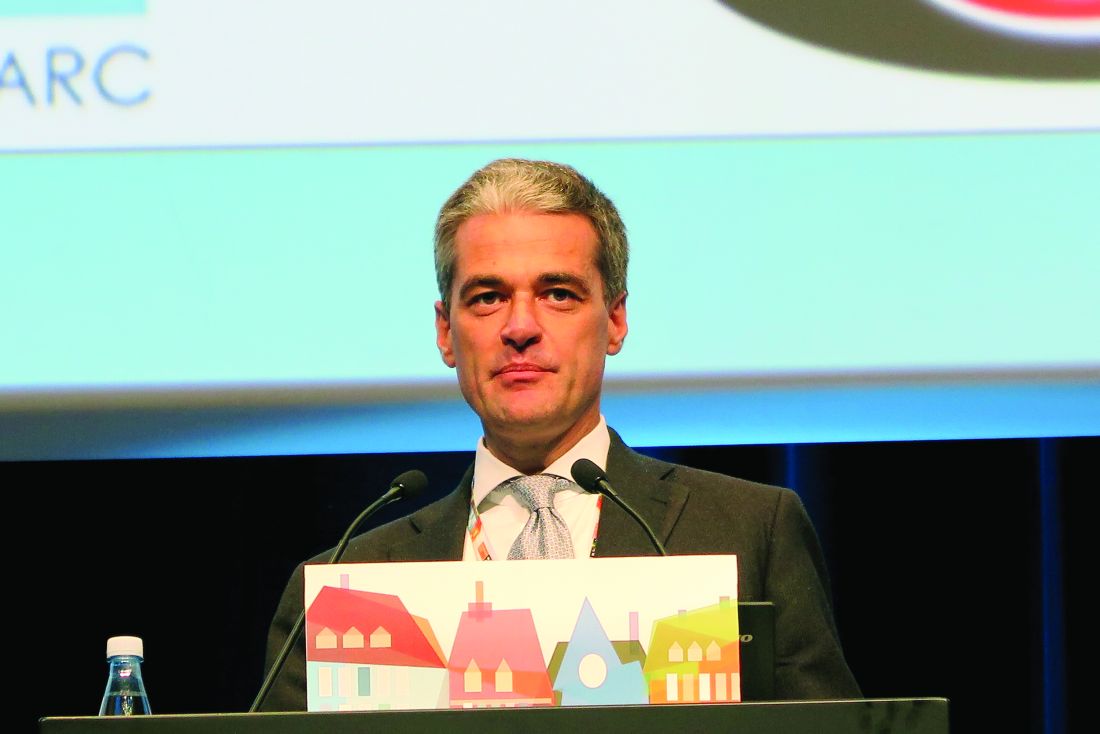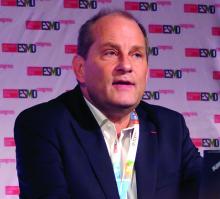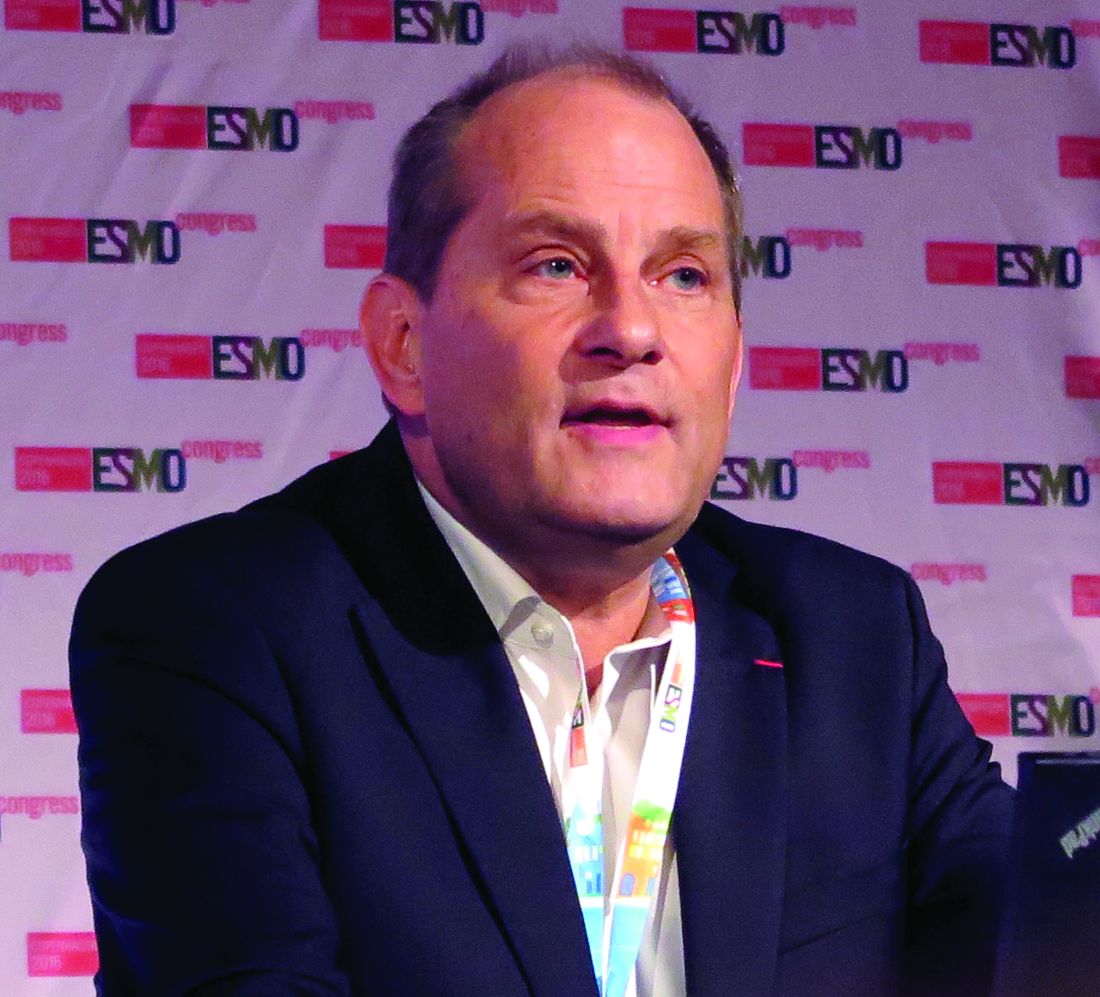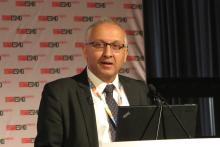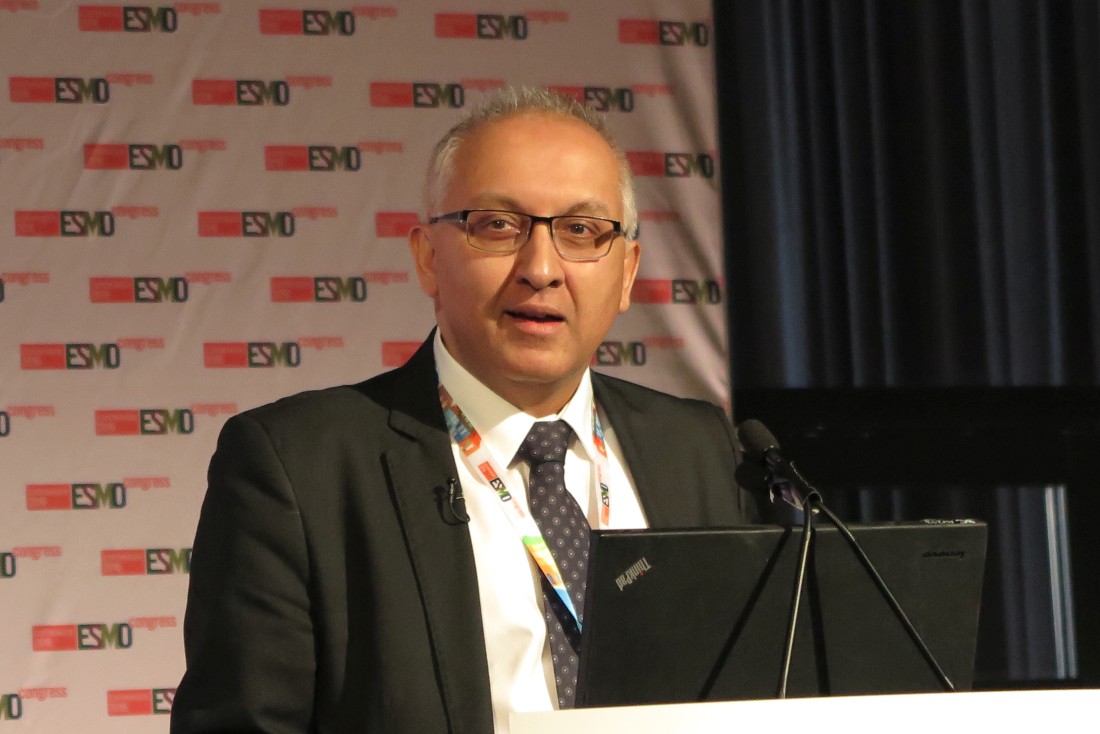User login
FALCON airs PFS edge for fulvestrant in ER+ breast cancer
COPENHAGEN – Fulvestrant continues to show superiority over anastrozole in treatment of hormone receptor-positive breast cancer, particularly in women with lower-volume disease, reported investigators in the phase III FALCON trial.
At a median follow-up of 25 months, median progression-free survival (PFS) for women assigned to receive the selective estrogen-receptor degrader fulvestrant (Faslodex) was 16.6 months, compared with 13.8 months for women assigned to receive the aromatase inhibitor anastrozole (Arimidex), reported Matthew J. Ellis, PhD, of the Lester and Sue Smith Breast Center at Baylor College of Medicine in Houston.
“These results are consistent with data from the FIRST study and confirm that fulvestrant is more efficacious than anastrozole in postmenopausal women with hormone receptor–positive locally advanced or metastatic breast cancer who have not received prior endocrine therapy,” he said at the European Society for Medical Oncology Congress.
The benefit of fulvestrant appeared to be only among patients who did not have visceral metastases, however.
In the FIRST study, results of which were reported at the San Antonio Breast Cancer Symposium in 2014, median overall survival at a median follow-up of 48.8 months was 54.1 months in patients on fulvestrant, vs. 48.4 months with anastrozole (hazard ratio [HR] 0.70, P = .04). The median PFS durations were 23.4 months vs. 13.1 months, respectively (HR 0.66, P = .01).
The FALCON (Fulvestrant and Anastrozole Compared in Hormonal Therapy-Naive Advanced Breast Cancer) trial was a phase III study designed to confirm the PFS benefit seen with fulvestrant in the earlier trial.
Postmenopausal women with locally advanced or metastatic breast cancer positive for the estrogen and/or progesterone receptor and negative for HER2 who had not previously received endocrine therapy were enrolled. They were randomly assigned to receive fulvestrant 500 mg intramuscularly on days 0, 14, and 28 then every 28 days plus an anastrozole placebo (232 patients), or oral anastrozole 1 mg daily plus fulvestrant placebo (230 patients).
Women with life-threatening visceral metastases, systemic estrogen-containing hormone replacement therapy within 6 months of randomization, or prior systemic treatment for breast cancer other than one line of chemotherapy or radiotherapy within 28 days of randomization (except radiation for control of bone pain) were excluded.
As noted, the primary endpoint of PFS was 16.6 months in the fulvestrant arm vs. 13.8 months in the anastrozole arm, translating into an HR for progression on fulvestrant of 0.797 (P = .0486).
Among the 208 patients with no visceral disease, median PFS with fulvestrant was 22.3 months, vs. 13.8 months (HR 0.59, P less than .01). In contrast, among the 254 patients with visceral disease, the respective median PFS durations were 13.8 and 15.9 months (nonsignificant).
For the secondary endpoint of overall survival, at 31% maturity (longest follow-up out to 39 months), there was no significant difference between the study arms.
There were also no significant differences in the secondary endpoints of overall response rate (among patients with measurable disease at baseline), clinical benefit rate, median duration of response, median duration of clinical benefit, or median time to deterioration of total score on the Functional Assessment of Cancer Therapy–Breast (FACT-B) patient-reported outcomes instrument.
Only estimated duration of response (11.4 vs. 7.5 months) and estimated duration of clinical benefit (21.9 vs. 17.5 months) were significantly better with fulvestrant (P less than .001 for each).
Grade 3 or greater adverse events occurred in 22.4% vs. 17.7%. Deaths from adverse events occurred in six patients on fulvestrant vs. seven on anastrozole. None of these deaths were considered to be related.
The FALCON results, which showed a benefit for fulvestrant only for those patients without visceral disease, point to a need for investigating whether patients with visceral metastases should receive other therapies, but this observation is hypothesis-generating only, said invited discussant Peter Schmid, MD, PhD, of Barts Cancer Institute at St. Bartholomew’s Hospital at Queen Mary University of London.
COPENHAGEN – Fulvestrant continues to show superiority over anastrozole in treatment of hormone receptor-positive breast cancer, particularly in women with lower-volume disease, reported investigators in the phase III FALCON trial.
At a median follow-up of 25 months, median progression-free survival (PFS) for women assigned to receive the selective estrogen-receptor degrader fulvestrant (Faslodex) was 16.6 months, compared with 13.8 months for women assigned to receive the aromatase inhibitor anastrozole (Arimidex), reported Matthew J. Ellis, PhD, of the Lester and Sue Smith Breast Center at Baylor College of Medicine in Houston.
“These results are consistent with data from the FIRST study and confirm that fulvestrant is more efficacious than anastrozole in postmenopausal women with hormone receptor–positive locally advanced or metastatic breast cancer who have not received prior endocrine therapy,” he said at the European Society for Medical Oncology Congress.
The benefit of fulvestrant appeared to be only among patients who did not have visceral metastases, however.
In the FIRST study, results of which were reported at the San Antonio Breast Cancer Symposium in 2014, median overall survival at a median follow-up of 48.8 months was 54.1 months in patients on fulvestrant, vs. 48.4 months with anastrozole (hazard ratio [HR] 0.70, P = .04). The median PFS durations were 23.4 months vs. 13.1 months, respectively (HR 0.66, P = .01).
The FALCON (Fulvestrant and Anastrozole Compared in Hormonal Therapy-Naive Advanced Breast Cancer) trial was a phase III study designed to confirm the PFS benefit seen with fulvestrant in the earlier trial.
Postmenopausal women with locally advanced or metastatic breast cancer positive for the estrogen and/or progesterone receptor and negative for HER2 who had not previously received endocrine therapy were enrolled. They were randomly assigned to receive fulvestrant 500 mg intramuscularly on days 0, 14, and 28 then every 28 days plus an anastrozole placebo (232 patients), or oral anastrozole 1 mg daily plus fulvestrant placebo (230 patients).
Women with life-threatening visceral metastases, systemic estrogen-containing hormone replacement therapy within 6 months of randomization, or prior systemic treatment for breast cancer other than one line of chemotherapy or radiotherapy within 28 days of randomization (except radiation for control of bone pain) were excluded.
As noted, the primary endpoint of PFS was 16.6 months in the fulvestrant arm vs. 13.8 months in the anastrozole arm, translating into an HR for progression on fulvestrant of 0.797 (P = .0486).
Among the 208 patients with no visceral disease, median PFS with fulvestrant was 22.3 months, vs. 13.8 months (HR 0.59, P less than .01). In contrast, among the 254 patients with visceral disease, the respective median PFS durations were 13.8 and 15.9 months (nonsignificant).
For the secondary endpoint of overall survival, at 31% maturity (longest follow-up out to 39 months), there was no significant difference between the study arms.
There were also no significant differences in the secondary endpoints of overall response rate (among patients with measurable disease at baseline), clinical benefit rate, median duration of response, median duration of clinical benefit, or median time to deterioration of total score on the Functional Assessment of Cancer Therapy–Breast (FACT-B) patient-reported outcomes instrument.
Only estimated duration of response (11.4 vs. 7.5 months) and estimated duration of clinical benefit (21.9 vs. 17.5 months) were significantly better with fulvestrant (P less than .001 for each).
Grade 3 or greater adverse events occurred in 22.4% vs. 17.7%. Deaths from adverse events occurred in six patients on fulvestrant vs. seven on anastrozole. None of these deaths were considered to be related.
The FALCON results, which showed a benefit for fulvestrant only for those patients without visceral disease, point to a need for investigating whether patients with visceral metastases should receive other therapies, but this observation is hypothesis-generating only, said invited discussant Peter Schmid, MD, PhD, of Barts Cancer Institute at St. Bartholomew’s Hospital at Queen Mary University of London.
COPENHAGEN – Fulvestrant continues to show superiority over anastrozole in treatment of hormone receptor-positive breast cancer, particularly in women with lower-volume disease, reported investigators in the phase III FALCON trial.
At a median follow-up of 25 months, median progression-free survival (PFS) for women assigned to receive the selective estrogen-receptor degrader fulvestrant (Faslodex) was 16.6 months, compared with 13.8 months for women assigned to receive the aromatase inhibitor anastrozole (Arimidex), reported Matthew J. Ellis, PhD, of the Lester and Sue Smith Breast Center at Baylor College of Medicine in Houston.
“These results are consistent with data from the FIRST study and confirm that fulvestrant is more efficacious than anastrozole in postmenopausal women with hormone receptor–positive locally advanced or metastatic breast cancer who have not received prior endocrine therapy,” he said at the European Society for Medical Oncology Congress.
The benefit of fulvestrant appeared to be only among patients who did not have visceral metastases, however.
In the FIRST study, results of which were reported at the San Antonio Breast Cancer Symposium in 2014, median overall survival at a median follow-up of 48.8 months was 54.1 months in patients on fulvestrant, vs. 48.4 months with anastrozole (hazard ratio [HR] 0.70, P = .04). The median PFS durations were 23.4 months vs. 13.1 months, respectively (HR 0.66, P = .01).
The FALCON (Fulvestrant and Anastrozole Compared in Hormonal Therapy-Naive Advanced Breast Cancer) trial was a phase III study designed to confirm the PFS benefit seen with fulvestrant in the earlier trial.
Postmenopausal women with locally advanced or metastatic breast cancer positive for the estrogen and/or progesterone receptor and negative for HER2 who had not previously received endocrine therapy were enrolled. They were randomly assigned to receive fulvestrant 500 mg intramuscularly on days 0, 14, and 28 then every 28 days plus an anastrozole placebo (232 patients), or oral anastrozole 1 mg daily plus fulvestrant placebo (230 patients).
Women with life-threatening visceral metastases, systemic estrogen-containing hormone replacement therapy within 6 months of randomization, or prior systemic treatment for breast cancer other than one line of chemotherapy or radiotherapy within 28 days of randomization (except radiation for control of bone pain) were excluded.
As noted, the primary endpoint of PFS was 16.6 months in the fulvestrant arm vs. 13.8 months in the anastrozole arm, translating into an HR for progression on fulvestrant of 0.797 (P = .0486).
Among the 208 patients with no visceral disease, median PFS with fulvestrant was 22.3 months, vs. 13.8 months (HR 0.59, P less than .01). In contrast, among the 254 patients with visceral disease, the respective median PFS durations were 13.8 and 15.9 months (nonsignificant).
For the secondary endpoint of overall survival, at 31% maturity (longest follow-up out to 39 months), there was no significant difference between the study arms.
There were also no significant differences in the secondary endpoints of overall response rate (among patients with measurable disease at baseline), clinical benefit rate, median duration of response, median duration of clinical benefit, or median time to deterioration of total score on the Functional Assessment of Cancer Therapy–Breast (FACT-B) patient-reported outcomes instrument.
Only estimated duration of response (11.4 vs. 7.5 months) and estimated duration of clinical benefit (21.9 vs. 17.5 months) were significantly better with fulvestrant (P less than .001 for each).
Grade 3 or greater adverse events occurred in 22.4% vs. 17.7%. Deaths from adverse events occurred in six patients on fulvestrant vs. seven on anastrozole. None of these deaths were considered to be related.
The FALCON results, which showed a benefit for fulvestrant only for those patients without visceral disease, point to a need for investigating whether patients with visceral metastases should receive other therapies, but this observation is hypothesis-generating only, said invited discussant Peter Schmid, MD, PhD, of Barts Cancer Institute at St. Bartholomew’s Hospital at Queen Mary University of London.
AT ESMO 2016
Key clinical point: The selective estrogen receptor degrader fulvestrant continues to offer improved progression-free survival (PFS) compared with the aromatase inhibitor anastrozole.
Major finding: At a median 25 months’ follow-up, median PFS was 16.6 months for fulvestrant vs. 13.8 months for anastrozole.
Data source: Randomized phase III trial of 462 women with endocrine therapy–naive locally advanced metastatic hormone receptor–positive breast cancer.
Disclosures: FALCON was sponsored by AstraZeneca. Dr. Ellis reported consulting for AstraZeneca, and Dr. Schmid reported honoraria or consultation fees from the company.
Pembrolizumab ‘new standard of care’ in advanced PD-L1-rich NSCLC
COPENHAGEN – Chalk up another one for immunotherapy: the PD-1 checkpoint inhibitor pembrolizumab cut the risk of disease progression or death in half among select patients with non–small cell lung cancer (NSCLC), compared with standard platinum doublet chemotherapy, in the first-line setting.
Among 305 patients with non–small cell lung cancers with 50% or greater expression of the programmed death ligand 1 (PD-L1), median progression-free survival (PFS) for patients treated with pembrolizumab (Keytruda) was 10.3 months, compared with 6 months for patients assigned to receive platinum-based chemotherapy at the investigators discretion (hazard ratio, 0.50, P less than .001), reported Martin Reck, MD, from the department of thoracic oncology at the Lung Clinic Grosshansdorf, in Germany.
Results of the KEYNOTE-024 study were also published online in the New England Journal of Medicine (2016 Oct 9. doi: 10.1056/NEJMoa1606774). Approximately 23%-30% of patients with advanced non–small cell lung cancers have tumors that express PD-L1 on the membrane of at least 50% of tumor cells, making them attractive targets for pembrolizumab, which is a monoclonal antibody directed against programmed death 1 (PD-1). Pembrolizumab disengages the brake on the immune system caused by the interaction of receptor PD-1 with the PD-L1 and PD-L2 ligands.
The study was conducted to compare upfront pembrolizumab with platinum-based chemotherapy in patients with newly diagnosed advanced NSCLC that did not carry targetable EGFR-activating mutations or ALK translocations.
A total of 305 patients from 16 countries with untreated stage IV NSCLC, good performance status, and tumors with a 50% or greater expression of PD-L1 were enrolled and randomized to either pembrolizumab 200 mg intravenously every 3 weeks for up to 2 years. Or four to six cycles of platinum-doublet chemotherapy at the investigator’s discretion. The combinations included carboplatin plus pemetrexed, cisplatin plus pemetrexed, carboplatin plus gemcitabine, cisplatin plus gemcitabine, or carboplatin plus paclitaxel.
At a median follow-up of 11.2 months, 48.1% of patients assigned to pembrolizumab were still on treatment, as were 10% of those assigned to standard chemotherapy.
As noted before, PFS, the primary endpoint, was significantly better with pembrolizumab, as was the secondary endpoint of overall survival at 6 months. In all, 80% of patients treated with pembrolizumab were still alive at 6 months, compared with 72% of patients on chemotherapy (HR, 0.60; P = .005).
The confirmed response rate was also higher in the pembrolizumab arm, at 44.8% vs. 27.8%(P = .0011), and the median duration of response was longer (not reached vs. 6.3 months). There were six complete responses in the pembrolizumab arm.
Pembrolizumab also demonstrated a generally more favorable safety profile, with adverse events of any grade occurring in 73.4% of patients, compared with 90% of those treated with chemotherapy.
Grade 3 or 4 adverse events and treatment-related deaths were also lower in the pembrolizumab arm, at 26.6% vs. 53.3%.
Jean-Charles Soria, MD, chair of drug development at Gustave Roussy Cancer Center in Paris, the invited discussant, noted that the “45% objective response rate in first-line non–small cell lung cancer is unheard of, and is achieved with a monotherapy.”
“Pembrolizumab clearly leads to a higher objective response, a longer duration of response, a lower frequency of adverse events, better PFS, better OS, compared to chemotherapy.”
“We have, probably, a new standard of care” for patients with high PD-L1 expression and no targetable mutations,” he said.
COPENHAGEN – Chalk up another one for immunotherapy: the PD-1 checkpoint inhibitor pembrolizumab cut the risk of disease progression or death in half among select patients with non–small cell lung cancer (NSCLC), compared with standard platinum doublet chemotherapy, in the first-line setting.
Among 305 patients with non–small cell lung cancers with 50% or greater expression of the programmed death ligand 1 (PD-L1), median progression-free survival (PFS) for patients treated with pembrolizumab (Keytruda) was 10.3 months, compared with 6 months for patients assigned to receive platinum-based chemotherapy at the investigators discretion (hazard ratio, 0.50, P less than .001), reported Martin Reck, MD, from the department of thoracic oncology at the Lung Clinic Grosshansdorf, in Germany.
Results of the KEYNOTE-024 study were also published online in the New England Journal of Medicine (2016 Oct 9. doi: 10.1056/NEJMoa1606774). Approximately 23%-30% of patients with advanced non–small cell lung cancers have tumors that express PD-L1 on the membrane of at least 50% of tumor cells, making them attractive targets for pembrolizumab, which is a monoclonal antibody directed against programmed death 1 (PD-1). Pembrolizumab disengages the brake on the immune system caused by the interaction of receptor PD-1 with the PD-L1 and PD-L2 ligands.
The study was conducted to compare upfront pembrolizumab with platinum-based chemotherapy in patients with newly diagnosed advanced NSCLC that did not carry targetable EGFR-activating mutations or ALK translocations.
A total of 305 patients from 16 countries with untreated stage IV NSCLC, good performance status, and tumors with a 50% or greater expression of PD-L1 were enrolled and randomized to either pembrolizumab 200 mg intravenously every 3 weeks for up to 2 years. Or four to six cycles of platinum-doublet chemotherapy at the investigator’s discretion. The combinations included carboplatin plus pemetrexed, cisplatin plus pemetrexed, carboplatin plus gemcitabine, cisplatin plus gemcitabine, or carboplatin plus paclitaxel.
At a median follow-up of 11.2 months, 48.1% of patients assigned to pembrolizumab were still on treatment, as were 10% of those assigned to standard chemotherapy.
As noted before, PFS, the primary endpoint, was significantly better with pembrolizumab, as was the secondary endpoint of overall survival at 6 months. In all, 80% of patients treated with pembrolizumab were still alive at 6 months, compared with 72% of patients on chemotherapy (HR, 0.60; P = .005).
The confirmed response rate was also higher in the pembrolizumab arm, at 44.8% vs. 27.8%(P = .0011), and the median duration of response was longer (not reached vs. 6.3 months). There were six complete responses in the pembrolizumab arm.
Pembrolizumab also demonstrated a generally more favorable safety profile, with adverse events of any grade occurring in 73.4% of patients, compared with 90% of those treated with chemotherapy.
Grade 3 or 4 adverse events and treatment-related deaths were also lower in the pembrolizumab arm, at 26.6% vs. 53.3%.
Jean-Charles Soria, MD, chair of drug development at Gustave Roussy Cancer Center in Paris, the invited discussant, noted that the “45% objective response rate in first-line non–small cell lung cancer is unheard of, and is achieved with a monotherapy.”
“Pembrolizumab clearly leads to a higher objective response, a longer duration of response, a lower frequency of adverse events, better PFS, better OS, compared to chemotherapy.”
“We have, probably, a new standard of care” for patients with high PD-L1 expression and no targetable mutations,” he said.
COPENHAGEN – Chalk up another one for immunotherapy: the PD-1 checkpoint inhibitor pembrolizumab cut the risk of disease progression or death in half among select patients with non–small cell lung cancer (NSCLC), compared with standard platinum doublet chemotherapy, in the first-line setting.
Among 305 patients with non–small cell lung cancers with 50% or greater expression of the programmed death ligand 1 (PD-L1), median progression-free survival (PFS) for patients treated with pembrolizumab (Keytruda) was 10.3 months, compared with 6 months for patients assigned to receive platinum-based chemotherapy at the investigators discretion (hazard ratio, 0.50, P less than .001), reported Martin Reck, MD, from the department of thoracic oncology at the Lung Clinic Grosshansdorf, in Germany.
Results of the KEYNOTE-024 study were also published online in the New England Journal of Medicine (2016 Oct 9. doi: 10.1056/NEJMoa1606774). Approximately 23%-30% of patients with advanced non–small cell lung cancers have tumors that express PD-L1 on the membrane of at least 50% of tumor cells, making them attractive targets for pembrolizumab, which is a monoclonal antibody directed against programmed death 1 (PD-1). Pembrolizumab disengages the brake on the immune system caused by the interaction of receptor PD-1 with the PD-L1 and PD-L2 ligands.
The study was conducted to compare upfront pembrolizumab with platinum-based chemotherapy in patients with newly diagnosed advanced NSCLC that did not carry targetable EGFR-activating mutations or ALK translocations.
A total of 305 patients from 16 countries with untreated stage IV NSCLC, good performance status, and tumors with a 50% or greater expression of PD-L1 were enrolled and randomized to either pembrolizumab 200 mg intravenously every 3 weeks for up to 2 years. Or four to six cycles of platinum-doublet chemotherapy at the investigator’s discretion. The combinations included carboplatin plus pemetrexed, cisplatin plus pemetrexed, carboplatin plus gemcitabine, cisplatin plus gemcitabine, or carboplatin plus paclitaxel.
At a median follow-up of 11.2 months, 48.1% of patients assigned to pembrolizumab were still on treatment, as were 10% of those assigned to standard chemotherapy.
As noted before, PFS, the primary endpoint, was significantly better with pembrolizumab, as was the secondary endpoint of overall survival at 6 months. In all, 80% of patients treated with pembrolizumab were still alive at 6 months, compared with 72% of patients on chemotherapy (HR, 0.60; P = .005).
The confirmed response rate was also higher in the pembrolizumab arm, at 44.8% vs. 27.8%(P = .0011), and the median duration of response was longer (not reached vs. 6.3 months). There were six complete responses in the pembrolizumab arm.
Pembrolizumab also demonstrated a generally more favorable safety profile, with adverse events of any grade occurring in 73.4% of patients, compared with 90% of those treated with chemotherapy.
Grade 3 or 4 adverse events and treatment-related deaths were also lower in the pembrolizumab arm, at 26.6% vs. 53.3%.
Jean-Charles Soria, MD, chair of drug development at Gustave Roussy Cancer Center in Paris, the invited discussant, noted that the “45% objective response rate in first-line non–small cell lung cancer is unheard of, and is achieved with a monotherapy.”
“Pembrolizumab clearly leads to a higher objective response, a longer duration of response, a lower frequency of adverse events, better PFS, better OS, compared to chemotherapy.”
“We have, probably, a new standard of care” for patients with high PD-L1 expression and no targetable mutations,” he said.
AT ESMO 2016
Key clinical point: Pembrolizumab was superior to chemotherapy in stage IV NSCLC with PD-L1 expression of 50% or more.
Major finding: The hazard ratio for progression-free survival was 0.50 for pembrolizumab vs. platinum-based chemotherapy.
Data source: Randomized phase III trial in 305 patients with untreated stage IV NSCLC with 50% or more of tumor cells expressing PD-L1
Disclosures: The study was sponsored by Merck, Sharp & Dohme. Dr. Reck and Dr. Soria disclosed financial relationships (consulting/honoraria, research funding, etc.) with several companies, but not Merck.
OAK: Atezolizumab grows OS in advanced NSCLC
COPENHAGEN – The checkpoint inhibitor atezolizumab improved overall survival of advanced non–small-cell lung cancer, compared with docetaxel, primary analysis from the OAK trial shows.
In the first phase III trial of a monoclonal antibody directed against the programmed death 1 ligand (PD-L1) in non–small-lung cell lung cancer (NSCLC), median overall survival (OS) for patients assigned to atezolizumab (Tecentriq) was 13.8 months, compared with 9.6 months for patients assigned to docetaxel, reported Fabrice Barlesi, MD, head of the multidisciplinary oncology and therapeutic innovations department at Aix-Marseille University and the Assistance Publique Hôpitaux de Marseille, France.
Atezolizumab was previously shown in the phase II POPLAR trial to significantly increase overall survival compared with docetaxel in second- or third-line therapy in patients with locally advanced or metastatic NSCLC who had disease progression after platinum-based chemotherapy.
The OAK trial investigators enrolled 1,225 patients with locally advanced or metastatic NSCLC following one or two prior lines of therapy that contained at least one platinum-based regimen. The patients could have any degree of PD-L1 expression.
Dr. Barlesi presented results of a prespecified intention-to-treat analysis of the first 850 patients enrolled.
Following stratification for PD-L1, histology, and prior chemotherapy regimens, they were randomly assigned to either atezolizumab 1,200 mg IV every 3 weeks or docetaxel 75 mg/m2 every 3 weeks. In the atezolizumab arm, therapy could be continued until disease progression or clinical benefit. In the docetaxel arm, therapy was continued until progression.
As noted, atezolizumab was associated with significantly better OS, the primary endpoint (13.8 vs. 9.6 months) with a hazard ratio (HR) of 0.73 (P = .0003). OS rates at 12 months were 55% in the atezolizumab arm vs. 41% in the docetaxel arm, and at 18 months the rates were 40% and 27%, respectively.
The investigators found that atezolizumab provided a benefit regardless of PD-L1 expression, with a hazard ratio of 0.74 (P = .0102) for the 55% of patients with PD-L1 expression on at least 1% of their tumor cells, and 0.75 (P = .0205) for patients with PD-L1 on less than 1% of tumor cells.
Median overall survival was greater with both drugs for patients with higher levels of PD-L1 expression, with a median of 15.7 months for those treated with atezolizumab and 10.3 months for those treated with docetaxel. In contrast, the respective median overall survival durations in the patients with less than 1% PD-L1 expression were 12.6 and 8.9 months.
The greatest benefit for atezolizumab was seen in patients with PD-L1 expression of 50% or more of tumor cells or 10% or more of tumor-infiltrating immune cells, with a median OS at a minimum follow-up of 19 months of 20.5 months vs. 8.9 months, translating into a hazard ratio for atezolizumab of 0.41 (P less than .0001).
An analysis of OS by histology showed HRs of 0.73 for atezolizumab for patients with either non-squamous tumors (P = .0015) or squamous tumors (P = .0383). In addition, an analysis of OS in selected subgroups showed a trend favoring atezolizumab in patients who had never smoked, who tend to have a worse prognosis than would current or former smokers.
In an analysis of progression-free survival, there was no significant difference between the groups (median 4.0 vs. 2.8 months).
Adverse events of grade 3 or greater of any cause were lower with atezolizumab, at 37% vs. 54%. There was one treatment-related death from respiratory infection in a patient who received docetaxel.
Invited discussant Naiyer Rizvi, MD, an oncologist at Columbia University Medical Center in New York, said that the OAK trial confirms that atezolizumab is an appropriate second-line therapy for unselected patients with advanced NSCLC, and should be explored for its potential survival benefits in never smokers.
COPENHAGEN – The checkpoint inhibitor atezolizumab improved overall survival of advanced non–small-cell lung cancer, compared with docetaxel, primary analysis from the OAK trial shows.
In the first phase III trial of a monoclonal antibody directed against the programmed death 1 ligand (PD-L1) in non–small-lung cell lung cancer (NSCLC), median overall survival (OS) for patients assigned to atezolizumab (Tecentriq) was 13.8 months, compared with 9.6 months for patients assigned to docetaxel, reported Fabrice Barlesi, MD, head of the multidisciplinary oncology and therapeutic innovations department at Aix-Marseille University and the Assistance Publique Hôpitaux de Marseille, France.
Atezolizumab was previously shown in the phase II POPLAR trial to significantly increase overall survival compared with docetaxel in second- or third-line therapy in patients with locally advanced or metastatic NSCLC who had disease progression after platinum-based chemotherapy.
The OAK trial investigators enrolled 1,225 patients with locally advanced or metastatic NSCLC following one or two prior lines of therapy that contained at least one platinum-based regimen. The patients could have any degree of PD-L1 expression.
Dr. Barlesi presented results of a prespecified intention-to-treat analysis of the first 850 patients enrolled.
Following stratification for PD-L1, histology, and prior chemotherapy regimens, they were randomly assigned to either atezolizumab 1,200 mg IV every 3 weeks or docetaxel 75 mg/m2 every 3 weeks. In the atezolizumab arm, therapy could be continued until disease progression or clinical benefit. In the docetaxel arm, therapy was continued until progression.
As noted, atezolizumab was associated with significantly better OS, the primary endpoint (13.8 vs. 9.6 months) with a hazard ratio (HR) of 0.73 (P = .0003). OS rates at 12 months were 55% in the atezolizumab arm vs. 41% in the docetaxel arm, and at 18 months the rates were 40% and 27%, respectively.
The investigators found that atezolizumab provided a benefit regardless of PD-L1 expression, with a hazard ratio of 0.74 (P = .0102) for the 55% of patients with PD-L1 expression on at least 1% of their tumor cells, and 0.75 (P = .0205) for patients with PD-L1 on less than 1% of tumor cells.
Median overall survival was greater with both drugs for patients with higher levels of PD-L1 expression, with a median of 15.7 months for those treated with atezolizumab and 10.3 months for those treated with docetaxel. In contrast, the respective median overall survival durations in the patients with less than 1% PD-L1 expression were 12.6 and 8.9 months.
The greatest benefit for atezolizumab was seen in patients with PD-L1 expression of 50% or more of tumor cells or 10% or more of tumor-infiltrating immune cells, with a median OS at a minimum follow-up of 19 months of 20.5 months vs. 8.9 months, translating into a hazard ratio for atezolizumab of 0.41 (P less than .0001).
An analysis of OS by histology showed HRs of 0.73 for atezolizumab for patients with either non-squamous tumors (P = .0015) or squamous tumors (P = .0383). In addition, an analysis of OS in selected subgroups showed a trend favoring atezolizumab in patients who had never smoked, who tend to have a worse prognosis than would current or former smokers.
In an analysis of progression-free survival, there was no significant difference between the groups (median 4.0 vs. 2.8 months).
Adverse events of grade 3 or greater of any cause were lower with atezolizumab, at 37% vs. 54%. There was one treatment-related death from respiratory infection in a patient who received docetaxel.
Invited discussant Naiyer Rizvi, MD, an oncologist at Columbia University Medical Center in New York, said that the OAK trial confirms that atezolizumab is an appropriate second-line therapy for unselected patients with advanced NSCLC, and should be explored for its potential survival benefits in never smokers.
COPENHAGEN – The checkpoint inhibitor atezolizumab improved overall survival of advanced non–small-cell lung cancer, compared with docetaxel, primary analysis from the OAK trial shows.
In the first phase III trial of a monoclonal antibody directed against the programmed death 1 ligand (PD-L1) in non–small-lung cell lung cancer (NSCLC), median overall survival (OS) for patients assigned to atezolizumab (Tecentriq) was 13.8 months, compared with 9.6 months for patients assigned to docetaxel, reported Fabrice Barlesi, MD, head of the multidisciplinary oncology and therapeutic innovations department at Aix-Marseille University and the Assistance Publique Hôpitaux de Marseille, France.
Atezolizumab was previously shown in the phase II POPLAR trial to significantly increase overall survival compared with docetaxel in second- or third-line therapy in patients with locally advanced or metastatic NSCLC who had disease progression after platinum-based chemotherapy.
The OAK trial investigators enrolled 1,225 patients with locally advanced or metastatic NSCLC following one or two prior lines of therapy that contained at least one platinum-based regimen. The patients could have any degree of PD-L1 expression.
Dr. Barlesi presented results of a prespecified intention-to-treat analysis of the first 850 patients enrolled.
Following stratification for PD-L1, histology, and prior chemotherapy regimens, they were randomly assigned to either atezolizumab 1,200 mg IV every 3 weeks or docetaxel 75 mg/m2 every 3 weeks. In the atezolizumab arm, therapy could be continued until disease progression or clinical benefit. In the docetaxel arm, therapy was continued until progression.
As noted, atezolizumab was associated with significantly better OS, the primary endpoint (13.8 vs. 9.6 months) with a hazard ratio (HR) of 0.73 (P = .0003). OS rates at 12 months were 55% in the atezolizumab arm vs. 41% in the docetaxel arm, and at 18 months the rates were 40% and 27%, respectively.
The investigators found that atezolizumab provided a benefit regardless of PD-L1 expression, with a hazard ratio of 0.74 (P = .0102) for the 55% of patients with PD-L1 expression on at least 1% of their tumor cells, and 0.75 (P = .0205) for patients with PD-L1 on less than 1% of tumor cells.
Median overall survival was greater with both drugs for patients with higher levels of PD-L1 expression, with a median of 15.7 months for those treated with atezolizumab and 10.3 months for those treated with docetaxel. In contrast, the respective median overall survival durations in the patients with less than 1% PD-L1 expression were 12.6 and 8.9 months.
The greatest benefit for atezolizumab was seen in patients with PD-L1 expression of 50% or more of tumor cells or 10% or more of tumor-infiltrating immune cells, with a median OS at a minimum follow-up of 19 months of 20.5 months vs. 8.9 months, translating into a hazard ratio for atezolizumab of 0.41 (P less than .0001).
An analysis of OS by histology showed HRs of 0.73 for atezolizumab for patients with either non-squamous tumors (P = .0015) or squamous tumors (P = .0383). In addition, an analysis of OS in selected subgroups showed a trend favoring atezolizumab in patients who had never smoked, who tend to have a worse prognosis than would current or former smokers.
In an analysis of progression-free survival, there was no significant difference between the groups (median 4.0 vs. 2.8 months).
Adverse events of grade 3 or greater of any cause were lower with atezolizumab, at 37% vs. 54%. There was one treatment-related death from respiratory infection in a patient who received docetaxel.
Invited discussant Naiyer Rizvi, MD, an oncologist at Columbia University Medical Center in New York, said that the OAK trial confirms that atezolizumab is an appropriate second-line therapy for unselected patients with advanced NSCLC, and should be explored for its potential survival benefits in never smokers.
AT ESMO 2016
Key clinical point: Atezolizumab improved overall survival (OS), compared with docetaxel, in patients with advanced non–small-cell lung cancer.
Major finding: Median OS for patients assigned to atezolizumab was 13.8 months, compared with 9.6 months for patients assigned to docetaxel.
Data source: Prespecified analysis of a randomized phase III trial in 850 patients with metastatic or recurrent NSCLC after platinum-based chemotherapy.
Disclosures: The OAK trial was funded by F. Hoffman-La Roche. Dr. Barlesi disclosed consulting fees from that company and others. Dr, Rizvi disclosed consulting for Roche and other companies.
Cabozantinib used as first-line therapy prolongs PFS for metastatic RCC
COPENHAGEN – For patients with previously untreated intermediate- or poor-risk renal cell carcinoma (RCC), cabozantanib offers a progression-free survival benefit better than that seen with sunitinib, the current standard of care, reported investigators in the phase II CABOSUN trial.
After a median follow-up of 20.8 months, progression-free survival (PFS) for patients assigned to cabozantinib (Canbometyx) the primary endpoint, was a median 8.2 months, compared with 5.6 months for patients assigned to sunitinib, reported Toni K. Choueiri, MD, from the Dana-Farber Cancer Institute in Boston.
“Cabozantinib represents a potential new treatment option for patients with untreated renal cell carcinoma,” Dr. Choueiri said at the European Society for Medical Oncology (ESMO) congress.
Sunitinib (Sutent), a vascular endothelial growth factor receptor (VEGFR) tyrosine kinase inhibitor (TKI) is the standard first-line therapy for patients who present with metastatic RCC. But patients with intermediate- or poor-risk metastatic RCC have shorter survival on sunitinib compared with patients with favorable-risk disease, Dr. Choueiri noted.
Resistance to VEGFR inhibitors in clear-cell RCC can arise through inactivation of the Von Hippel-Lindau (VHL) gene, which leads to upregulation of MET, AXL, and VEGF receptors.
Increased expression of MET and AXL has been associated with resistant to VEGFR inhibitors and poor clinical outcomes, he explained.
Cabozantib is an oral small-molecular inhibitor of multiple tyrosine kinases, including VEGF receptors, MET, and AXL. It is approved in the United States and Europe for use in the second-line setting following prior therapy with a VEGFR inhibitor.
Trial details
In the CABOSUN trial, 157 treatment-naive patients with clear-cell RCC with measurable disease, Eastern Cooperative Oncology Group performance status 0-2 and intermediate- or poor-risk disease according to International Metastatic Renal Cell Carcinoma Database (IMDC) criteria were randomly assigned to receive either oral cabaozantinib 60 mg daily for 6 week cycles, or oral sunitinib 50 mg daily on a standard schedule of 4 weeks on and 2 weeks off.
Tumors were assessed according to Response Evaluation Criteria in Solid Tumors (RECIST) every other cycle, and treatment was continued to the point of disease progression or intolerable toxicity.
A total of 79 patients were assigned to cabozantinib, 78 received it, and 13 were still on the drug at the time of the data cutoff. In all, 78 patients were assigned to sunitinib, 72 received it, and 2 were continuing treatment at last follow-up. The efficacy analysis was by intention-to-treat, and the safety analysis as-treated.
As noted, median PFS was 8.2.months for cabozantinib vs. 5.6 months for sunitinib, The hazard ratio for cabozatinib was 0.69 (P = .012). A subgroup analysis showed a trend favoring cabozantinib in each risk group, but this was not significant except among patients with bone metastases (HR, 0.51; 95% confidence interval, 0.29-0.90).
The overall response rate among patients on cabozantib was 46%, compared with 18% for sunitinib. Complete responses were seen in one patient in each group, partial responses in 35 and 13, respectively, stable disease in 26 and 28, and disease progression in 14 and 20 (data on 3 and 16 patients were not evaluable).
The overall survival analysis hinted at a benefit for cabozantinib (HR, 0.80), but this was not statistically significant.
All cause grade 3 or 4 adverse events occurred in 65% of patients in the cabozantinib arm and 68% in the sunitinib arm. Events occurring more frequently with cabozantinib were hypertension (28% vs. 22%), elevated alanine aminotranseferase (5% vs. 0%), anorexia (5% vs. 0%), palmar-plantar erythrodysethesia (8% vs. 4%), and weight loss (4% vs. 0%).
There were 3 deaths possibly, probably, or definitely related to treatment among 3 patients on cabozantinib and 2 on sunitinib.
Favorable data, but wait and see
“I think cabozantinib is superior to sunitinib in poor and intermediate risk metastatic renal cell cancer,” said invited discussant Bernard Escudier, MD, from the Gustave Roussy Cancer Center in Paris.
“Cabozantinib is a potent VEGF inhibitor and is probably also active in good risk patients, although we need to see the data in these patients,” he said.
He added that a phase 3 study is warranted to confirm these conclusions, and that he will likely wait until those data are available before moving patients to cabozantinib in the first line.
The trial was supported by the National Cancer Institute. Dr. Choueiri disclosed advising and institutional research funding from Exelixis, maker of cabozantinib, and Pfizer, maker of sunitinib. Dr. Escudier disclosed receiving honoraria from each company.
COPENHAGEN – For patients with previously untreated intermediate- or poor-risk renal cell carcinoma (RCC), cabozantanib offers a progression-free survival benefit better than that seen with sunitinib, the current standard of care, reported investigators in the phase II CABOSUN trial.
After a median follow-up of 20.8 months, progression-free survival (PFS) for patients assigned to cabozantinib (Canbometyx) the primary endpoint, was a median 8.2 months, compared with 5.6 months for patients assigned to sunitinib, reported Toni K. Choueiri, MD, from the Dana-Farber Cancer Institute in Boston.
“Cabozantinib represents a potential new treatment option for patients with untreated renal cell carcinoma,” Dr. Choueiri said at the European Society for Medical Oncology (ESMO) congress.
Sunitinib (Sutent), a vascular endothelial growth factor receptor (VEGFR) tyrosine kinase inhibitor (TKI) is the standard first-line therapy for patients who present with metastatic RCC. But patients with intermediate- or poor-risk metastatic RCC have shorter survival on sunitinib compared with patients with favorable-risk disease, Dr. Choueiri noted.
Resistance to VEGFR inhibitors in clear-cell RCC can arise through inactivation of the Von Hippel-Lindau (VHL) gene, which leads to upregulation of MET, AXL, and VEGF receptors.
Increased expression of MET and AXL has been associated with resistant to VEGFR inhibitors and poor clinical outcomes, he explained.
Cabozantib is an oral small-molecular inhibitor of multiple tyrosine kinases, including VEGF receptors, MET, and AXL. It is approved in the United States and Europe for use in the second-line setting following prior therapy with a VEGFR inhibitor.
Trial details
In the CABOSUN trial, 157 treatment-naive patients with clear-cell RCC with measurable disease, Eastern Cooperative Oncology Group performance status 0-2 and intermediate- or poor-risk disease according to International Metastatic Renal Cell Carcinoma Database (IMDC) criteria were randomly assigned to receive either oral cabaozantinib 60 mg daily for 6 week cycles, or oral sunitinib 50 mg daily on a standard schedule of 4 weeks on and 2 weeks off.
Tumors were assessed according to Response Evaluation Criteria in Solid Tumors (RECIST) every other cycle, and treatment was continued to the point of disease progression or intolerable toxicity.
A total of 79 patients were assigned to cabozantinib, 78 received it, and 13 were still on the drug at the time of the data cutoff. In all, 78 patients were assigned to sunitinib, 72 received it, and 2 were continuing treatment at last follow-up. The efficacy analysis was by intention-to-treat, and the safety analysis as-treated.
As noted, median PFS was 8.2.months for cabozantinib vs. 5.6 months for sunitinib, The hazard ratio for cabozatinib was 0.69 (P = .012). A subgroup analysis showed a trend favoring cabozantinib in each risk group, but this was not significant except among patients with bone metastases (HR, 0.51; 95% confidence interval, 0.29-0.90).
The overall response rate among patients on cabozantib was 46%, compared with 18% for sunitinib. Complete responses were seen in one patient in each group, partial responses in 35 and 13, respectively, stable disease in 26 and 28, and disease progression in 14 and 20 (data on 3 and 16 patients were not evaluable).
The overall survival analysis hinted at a benefit for cabozantinib (HR, 0.80), but this was not statistically significant.
All cause grade 3 or 4 adverse events occurred in 65% of patients in the cabozantinib arm and 68% in the sunitinib arm. Events occurring more frequently with cabozantinib were hypertension (28% vs. 22%), elevated alanine aminotranseferase (5% vs. 0%), anorexia (5% vs. 0%), palmar-plantar erythrodysethesia (8% vs. 4%), and weight loss (4% vs. 0%).
There were 3 deaths possibly, probably, or definitely related to treatment among 3 patients on cabozantinib and 2 on sunitinib.
Favorable data, but wait and see
“I think cabozantinib is superior to sunitinib in poor and intermediate risk metastatic renal cell cancer,” said invited discussant Bernard Escudier, MD, from the Gustave Roussy Cancer Center in Paris.
“Cabozantinib is a potent VEGF inhibitor and is probably also active in good risk patients, although we need to see the data in these patients,” he said.
He added that a phase 3 study is warranted to confirm these conclusions, and that he will likely wait until those data are available before moving patients to cabozantinib in the first line.
The trial was supported by the National Cancer Institute. Dr. Choueiri disclosed advising and institutional research funding from Exelixis, maker of cabozantinib, and Pfizer, maker of sunitinib. Dr. Escudier disclosed receiving honoraria from each company.
COPENHAGEN – For patients with previously untreated intermediate- or poor-risk renal cell carcinoma (RCC), cabozantanib offers a progression-free survival benefit better than that seen with sunitinib, the current standard of care, reported investigators in the phase II CABOSUN trial.
After a median follow-up of 20.8 months, progression-free survival (PFS) for patients assigned to cabozantinib (Canbometyx) the primary endpoint, was a median 8.2 months, compared with 5.6 months for patients assigned to sunitinib, reported Toni K. Choueiri, MD, from the Dana-Farber Cancer Institute in Boston.
“Cabozantinib represents a potential new treatment option for patients with untreated renal cell carcinoma,” Dr. Choueiri said at the European Society for Medical Oncology (ESMO) congress.
Sunitinib (Sutent), a vascular endothelial growth factor receptor (VEGFR) tyrosine kinase inhibitor (TKI) is the standard first-line therapy for patients who present with metastatic RCC. But patients with intermediate- or poor-risk metastatic RCC have shorter survival on sunitinib compared with patients with favorable-risk disease, Dr. Choueiri noted.
Resistance to VEGFR inhibitors in clear-cell RCC can arise through inactivation of the Von Hippel-Lindau (VHL) gene, which leads to upregulation of MET, AXL, and VEGF receptors.
Increased expression of MET and AXL has been associated with resistant to VEGFR inhibitors and poor clinical outcomes, he explained.
Cabozantib is an oral small-molecular inhibitor of multiple tyrosine kinases, including VEGF receptors, MET, and AXL. It is approved in the United States and Europe for use in the second-line setting following prior therapy with a VEGFR inhibitor.
Trial details
In the CABOSUN trial, 157 treatment-naive patients with clear-cell RCC with measurable disease, Eastern Cooperative Oncology Group performance status 0-2 and intermediate- or poor-risk disease according to International Metastatic Renal Cell Carcinoma Database (IMDC) criteria were randomly assigned to receive either oral cabaozantinib 60 mg daily for 6 week cycles, or oral sunitinib 50 mg daily on a standard schedule of 4 weeks on and 2 weeks off.
Tumors were assessed according to Response Evaluation Criteria in Solid Tumors (RECIST) every other cycle, and treatment was continued to the point of disease progression or intolerable toxicity.
A total of 79 patients were assigned to cabozantinib, 78 received it, and 13 were still on the drug at the time of the data cutoff. In all, 78 patients were assigned to sunitinib, 72 received it, and 2 were continuing treatment at last follow-up. The efficacy analysis was by intention-to-treat, and the safety analysis as-treated.
As noted, median PFS was 8.2.months for cabozantinib vs. 5.6 months for sunitinib, The hazard ratio for cabozatinib was 0.69 (P = .012). A subgroup analysis showed a trend favoring cabozantinib in each risk group, but this was not significant except among patients with bone metastases (HR, 0.51; 95% confidence interval, 0.29-0.90).
The overall response rate among patients on cabozantib was 46%, compared with 18% for sunitinib. Complete responses were seen in one patient in each group, partial responses in 35 and 13, respectively, stable disease in 26 and 28, and disease progression in 14 and 20 (data on 3 and 16 patients were not evaluable).
The overall survival analysis hinted at a benefit for cabozantinib (HR, 0.80), but this was not statistically significant.
All cause grade 3 or 4 adverse events occurred in 65% of patients in the cabozantinib arm and 68% in the sunitinib arm. Events occurring more frequently with cabozantinib were hypertension (28% vs. 22%), elevated alanine aminotranseferase (5% vs. 0%), anorexia (5% vs. 0%), palmar-plantar erythrodysethesia (8% vs. 4%), and weight loss (4% vs. 0%).
There were 3 deaths possibly, probably, or definitely related to treatment among 3 patients on cabozantinib and 2 on sunitinib.
Favorable data, but wait and see
“I think cabozantinib is superior to sunitinib in poor and intermediate risk metastatic renal cell cancer,” said invited discussant Bernard Escudier, MD, from the Gustave Roussy Cancer Center in Paris.
“Cabozantinib is a potent VEGF inhibitor and is probably also active in good risk patients, although we need to see the data in these patients,” he said.
He added that a phase 3 study is warranted to confirm these conclusions, and that he will likely wait until those data are available before moving patients to cabozantinib in the first line.
The trial was supported by the National Cancer Institute. Dr. Choueiri disclosed advising and institutional research funding from Exelixis, maker of cabozantinib, and Pfizer, maker of sunitinib. Dr. Escudier disclosed receiving honoraria from each company.
AT ESMO 2016
Key clinical point:
Major finding: Median progression-free survival for patients assigned to cabozantinib was 8.2 months, compared with 5.6 months for patients assigned to sunitinib,
Data source: Randomized phase II trial involving 157 patients with previously untreated metastatic RCC.
Disclosures: The trial was supported by the National Cancer Institute. Dr. Choueiri disclosed advising and institutional research funding from Exelixis, maker of cabozantinib, and Pfizer, maker of sunitinib. Dr. Escudier disclosed receiving honoraria from each company.
Adjuvant sunitinib offers DFS edge in high-risk RCC
COPENHAGEN – In patients with high-risk locoregional clear cell renal cell (RCC) carcinoma, adjuvant therapy with sunitinib significantly prolonged disease-free survival, compared with placebo, reported investigators in a randomized, phase III trial.
Among 615 patients with clear cell RCC at high risk for recurrence following nephrectomy, the median duration of disease-free survival (DFS) by blinded central review was 6.8 years for patients treated with sunitinib (Sutent) for 1 year, compared with 5.6 years for patients assigned to placebo, reported Alain Ravaud, MD, PhD from Hôpital Saint André in Bordeaux, France.
“These results represent a major step forward in the clinical management of clear cell renal cell carcinoma,” he said at the European Society for Medical Oncology Congress.
The study was published simultaneously online in the New England Journal of Medicine.
Approximately 16% of all patients with RCC have locoregional (stage III) disease, which is associated with a 5-year survival rate of 53%. Up to 40% of patients with locoregional disease will have a relapse with metastases after nephrectomy, indicating a need for effective adjuvant therapy to reduce the risk of relapse in this population, Dr. Ravaud said.
However, to date, adjuvant therapy with either cytokines, hormones, immunotherapy, or radiotherapy has not been successful at preventing relapse, and the ASSURE trial, comparing sunitinib and sorafenib (Nexavar) with placebo showed that neither of the tyrosine kinase inhibitors (TKIs) improved survival, and each necessitated discontinuations due to toxicity, despite dose reductions, Dr. Ravaud noted.
The trial reported here, S-TRAC (Sunitinib as Adjuvant Treatment for Patients at High Risk of Recurrence of Renal Cell Carcinoma Following Nephrectomy), had different results, however.
A total of 615 patients with high-risk RCC were enrolled. High-risk disease was defined as stage T3, NO or Nx, M0, any Furhman grade and any Eastern Cooperative Oncology Group (ECOG) performance status; T4, N0 or NX, M0, any Fuhrman/ECOG status; or any T, N1-N2, M0, any Fuhrman/ECOG status.
Patients were stratified by risk groups, ECOG status, and country, then randomized to receive either sunitinib 50 mg daily or placebo on a 4 weeks–on, 2 weeks–off schedule for 1 year or until recurrence, unacceptable toxicity, or withdrawal of consent.
Central Reviewers Yes, Investigators No
As noted before, the duration of median DFS, the primary endpoint, was 14 months longer with sunitinib, translating into a hazard ratio (HR) of 0.76 (P = .03). This determination of DFS was performed by central reviewers blinded to treatment type.
However, DFS rates by investigators review, while numerically different between trial arms (6.5 years for sunitinib vs. 4.5 years in the placebo group), were not statistically significant (HR, 0.81, P = .08).
Overall survival data were not mature at the time of the data cutoff, with the median not reached in either group.
Treatment-emergent adverse events were seen in 99.7% of the patients in the sunitinib group and in 88.5% of controls. Investigators attributed adverse events to treatment in 98.4% of patients in the sunitinib arm and 75.7% of those in the placebo arm.
The most common adverse events in the sunitinib group were diarrhea, palmar-plantar erythrodysesthesia, hypertension, fatigue, and nausea.
Grade 3 or higher adverse events were reported in 194 patients (63.4%) in the sunitinib group and in 66 (21.7%) in the placebo group.
Interestingly, there were fewer dose reductions in the sunitinib group (34.3% vs. 46.4%) and fewer dose interruptions (2.0% vs. 13.2%), although more patients on sunitinib discontinued because of adverse events (28.1% vs. 5.6%).
The most common cause of death in each group was RCC, which accounted for 47 of 62 deaths (75.8%) in the sunitinib arm and 47 of 64 (73.4%) in the placebo arm. No death was attributed to treatment-associated toxicities.
Patients on sunitinib also had generally lower scores on quality of life scales, but the between-group differences did not reach the prespecified minimally important difference of 10 patients except for the domains of diarrhea and loss of appetite.
But having said that, he noted that, in S-TRAC as in ASSURE, the study was negative going by investigator rather than central review, and that the positive HR for central review in S-TRAC was near the significance boundary.
Overall, the quality of evidence supporting sunitinib in the adjuvant setting is weak, with benefits barely outweighing harms, and that the cost of the therapy, in light of the above, is high, Dr. Bex said.
He added that he would need to see mature overall survival data from S-TRAC and ASSURE, further results from other ongoing trials with sunitinib, and a positive meta-analysis of studies of vascular endothelial growth factor receptor tyrosine kinase inhibitors in the adjuvant setting before he would change his mind on the use of sunitinib and related agents.
The trial was supported by Pfizer. Dr. Ravaud and Dr. Bex disclosed consulting and research grants from Pfizer and other companies.
COPENHAGEN – In patients with high-risk locoregional clear cell renal cell (RCC) carcinoma, adjuvant therapy with sunitinib significantly prolonged disease-free survival, compared with placebo, reported investigators in a randomized, phase III trial.
Among 615 patients with clear cell RCC at high risk for recurrence following nephrectomy, the median duration of disease-free survival (DFS) by blinded central review was 6.8 years for patients treated with sunitinib (Sutent) for 1 year, compared with 5.6 years for patients assigned to placebo, reported Alain Ravaud, MD, PhD from Hôpital Saint André in Bordeaux, France.
“These results represent a major step forward in the clinical management of clear cell renal cell carcinoma,” he said at the European Society for Medical Oncology Congress.
The study was published simultaneously online in the New England Journal of Medicine.
Approximately 16% of all patients with RCC have locoregional (stage III) disease, which is associated with a 5-year survival rate of 53%. Up to 40% of patients with locoregional disease will have a relapse with metastases after nephrectomy, indicating a need for effective adjuvant therapy to reduce the risk of relapse in this population, Dr. Ravaud said.
However, to date, adjuvant therapy with either cytokines, hormones, immunotherapy, or radiotherapy has not been successful at preventing relapse, and the ASSURE trial, comparing sunitinib and sorafenib (Nexavar) with placebo showed that neither of the tyrosine kinase inhibitors (TKIs) improved survival, and each necessitated discontinuations due to toxicity, despite dose reductions, Dr. Ravaud noted.
The trial reported here, S-TRAC (Sunitinib as Adjuvant Treatment for Patients at High Risk of Recurrence of Renal Cell Carcinoma Following Nephrectomy), had different results, however.
A total of 615 patients with high-risk RCC were enrolled. High-risk disease was defined as stage T3, NO or Nx, M0, any Furhman grade and any Eastern Cooperative Oncology Group (ECOG) performance status; T4, N0 or NX, M0, any Fuhrman/ECOG status; or any T, N1-N2, M0, any Fuhrman/ECOG status.
Patients were stratified by risk groups, ECOG status, and country, then randomized to receive either sunitinib 50 mg daily or placebo on a 4 weeks–on, 2 weeks–off schedule for 1 year or until recurrence, unacceptable toxicity, or withdrawal of consent.
Central Reviewers Yes, Investigators No
As noted before, the duration of median DFS, the primary endpoint, was 14 months longer with sunitinib, translating into a hazard ratio (HR) of 0.76 (P = .03). This determination of DFS was performed by central reviewers blinded to treatment type.
However, DFS rates by investigators review, while numerically different between trial arms (6.5 years for sunitinib vs. 4.5 years in the placebo group), were not statistically significant (HR, 0.81, P = .08).
Overall survival data were not mature at the time of the data cutoff, with the median not reached in either group.
Treatment-emergent adverse events were seen in 99.7% of the patients in the sunitinib group and in 88.5% of controls. Investigators attributed adverse events to treatment in 98.4% of patients in the sunitinib arm and 75.7% of those in the placebo arm.
The most common adverse events in the sunitinib group were diarrhea, palmar-plantar erythrodysesthesia, hypertension, fatigue, and nausea.
Grade 3 or higher adverse events were reported in 194 patients (63.4%) in the sunitinib group and in 66 (21.7%) in the placebo group.
Interestingly, there were fewer dose reductions in the sunitinib group (34.3% vs. 46.4%) and fewer dose interruptions (2.0% vs. 13.2%), although more patients on sunitinib discontinued because of adverse events (28.1% vs. 5.6%).
The most common cause of death in each group was RCC, which accounted for 47 of 62 deaths (75.8%) in the sunitinib arm and 47 of 64 (73.4%) in the placebo arm. No death was attributed to treatment-associated toxicities.
Patients on sunitinib also had generally lower scores on quality of life scales, but the between-group differences did not reach the prespecified minimally important difference of 10 patients except for the domains of diarrhea and loss of appetite.
But having said that, he noted that, in S-TRAC as in ASSURE, the study was negative going by investigator rather than central review, and that the positive HR for central review in S-TRAC was near the significance boundary.
Overall, the quality of evidence supporting sunitinib in the adjuvant setting is weak, with benefits barely outweighing harms, and that the cost of the therapy, in light of the above, is high, Dr. Bex said.
He added that he would need to see mature overall survival data from S-TRAC and ASSURE, further results from other ongoing trials with sunitinib, and a positive meta-analysis of studies of vascular endothelial growth factor receptor tyrosine kinase inhibitors in the adjuvant setting before he would change his mind on the use of sunitinib and related agents.
The trial was supported by Pfizer. Dr. Ravaud and Dr. Bex disclosed consulting and research grants from Pfizer and other companies.
COPENHAGEN – In patients with high-risk locoregional clear cell renal cell (RCC) carcinoma, adjuvant therapy with sunitinib significantly prolonged disease-free survival, compared with placebo, reported investigators in a randomized, phase III trial.
Among 615 patients with clear cell RCC at high risk for recurrence following nephrectomy, the median duration of disease-free survival (DFS) by blinded central review was 6.8 years for patients treated with sunitinib (Sutent) for 1 year, compared with 5.6 years for patients assigned to placebo, reported Alain Ravaud, MD, PhD from Hôpital Saint André in Bordeaux, France.
“These results represent a major step forward in the clinical management of clear cell renal cell carcinoma,” he said at the European Society for Medical Oncology Congress.
The study was published simultaneously online in the New England Journal of Medicine.
Approximately 16% of all patients with RCC have locoregional (stage III) disease, which is associated with a 5-year survival rate of 53%. Up to 40% of patients with locoregional disease will have a relapse with metastases after nephrectomy, indicating a need for effective adjuvant therapy to reduce the risk of relapse in this population, Dr. Ravaud said.
However, to date, adjuvant therapy with either cytokines, hormones, immunotherapy, or radiotherapy has not been successful at preventing relapse, and the ASSURE trial, comparing sunitinib and sorafenib (Nexavar) with placebo showed that neither of the tyrosine kinase inhibitors (TKIs) improved survival, and each necessitated discontinuations due to toxicity, despite dose reductions, Dr. Ravaud noted.
The trial reported here, S-TRAC (Sunitinib as Adjuvant Treatment for Patients at High Risk of Recurrence of Renal Cell Carcinoma Following Nephrectomy), had different results, however.
A total of 615 patients with high-risk RCC were enrolled. High-risk disease was defined as stage T3, NO or Nx, M0, any Furhman grade and any Eastern Cooperative Oncology Group (ECOG) performance status; T4, N0 or NX, M0, any Fuhrman/ECOG status; or any T, N1-N2, M0, any Fuhrman/ECOG status.
Patients were stratified by risk groups, ECOG status, and country, then randomized to receive either sunitinib 50 mg daily or placebo on a 4 weeks–on, 2 weeks–off schedule for 1 year or until recurrence, unacceptable toxicity, or withdrawal of consent.
Central Reviewers Yes, Investigators No
As noted before, the duration of median DFS, the primary endpoint, was 14 months longer with sunitinib, translating into a hazard ratio (HR) of 0.76 (P = .03). This determination of DFS was performed by central reviewers blinded to treatment type.
However, DFS rates by investigators review, while numerically different between trial arms (6.5 years for sunitinib vs. 4.5 years in the placebo group), were not statistically significant (HR, 0.81, P = .08).
Overall survival data were not mature at the time of the data cutoff, with the median not reached in either group.
Treatment-emergent adverse events were seen in 99.7% of the patients in the sunitinib group and in 88.5% of controls. Investigators attributed adverse events to treatment in 98.4% of patients in the sunitinib arm and 75.7% of those in the placebo arm.
The most common adverse events in the sunitinib group were diarrhea, palmar-plantar erythrodysesthesia, hypertension, fatigue, and nausea.
Grade 3 or higher adverse events were reported in 194 patients (63.4%) in the sunitinib group and in 66 (21.7%) in the placebo group.
Interestingly, there were fewer dose reductions in the sunitinib group (34.3% vs. 46.4%) and fewer dose interruptions (2.0% vs. 13.2%), although more patients on sunitinib discontinued because of adverse events (28.1% vs. 5.6%).
The most common cause of death in each group was RCC, which accounted for 47 of 62 deaths (75.8%) in the sunitinib arm and 47 of 64 (73.4%) in the placebo arm. No death was attributed to treatment-associated toxicities.
Patients on sunitinib also had generally lower scores on quality of life scales, but the between-group differences did not reach the prespecified minimally important difference of 10 patients except for the domains of diarrhea and loss of appetite.
But having said that, he noted that, in S-TRAC as in ASSURE, the study was negative going by investigator rather than central review, and that the positive HR for central review in S-TRAC was near the significance boundary.
Overall, the quality of evidence supporting sunitinib in the adjuvant setting is weak, with benefits barely outweighing harms, and that the cost of the therapy, in light of the above, is high, Dr. Bex said.
He added that he would need to see mature overall survival data from S-TRAC and ASSURE, further results from other ongoing trials with sunitinib, and a positive meta-analysis of studies of vascular endothelial growth factor receptor tyrosine kinase inhibitors in the adjuvant setting before he would change his mind on the use of sunitinib and related agents.
The trial was supported by Pfizer. Dr. Ravaud and Dr. Bex disclosed consulting and research grants from Pfizer and other companies.
AT ESMO 2016
Key clinical point: S-TRAC is the first clinical trial to show a benefit of adjuvant drug therapy in renal cell carcinoma.
Major finding: The median duration of disease-free survival by central review was 6.8 years for patients randomized to sunitinib vs. 5.6 years for those randomized to placebo.
Data source: Phase III trial of adjuvant therapy following nephrectomy in 615 patients with high-risk clear cell RCC.
Disclosures: The trial was supported by Pfizer. Dr. Ravaud and Dr. Bex disclosed consulting and research grants from Pfizer and other companies.
Survival, QoL better with nivolumab for recurrent head and neck cancer
COPENHAGEN – Among patients with recurrent or metastatic squamous cell carcinoma of the head and neck, those treated with the programmed death ligand–1 checkpoint inhibitor nivolumab reported consistently better quality of life than patients treated with a standard second-line agent of the investigator’s choice.
In a substudy of the randomized phase III Checkmate 141 trial, patients treated with nivolumab (Opdivo) had consistently stable outcomes across three separate, validated quality of life (QoL) instruments, reported Kevin Harrington, MBBS, of Royal Marsden Hospital in London.
“Nivolumab is the first PD-L1 [programmed death ligand–1] inhibitor to demonstrate a significant improvement in overall survival, with greater tolerability and a quality of life benefit, compared with standard of care therapy,” he said at the European Society of Medical Oncology Congress.
The overall trial results were reported at the 2016 annual meeting of the American Association for Cancer Research, and published online in the New England Journal of Medicine to coincide with Dr. Harrington’s presentation.
In this open-label trial, 361 patients with squamous cell carcinoma of the head and neck (HNSCC) that recurred or progressed within 6 months of completion of platinum-based chemotherapy were randomly assigned on a 2:1 basis to receive either nivolumab 3 mg/kg every 2 weeks, or standard, single-agent systemic chemotherapy with either methotrexate, docetaxel, or cetuximab.
After a median follow-up of 5.1 months (range, 0-16.8 months), the median overall survival, the primary endpoint, was 7.5 months for patients on nivolumab, compared with 5.1 months for those on standard therapy. The hazard ratio for death with nivolumab was 0.70 (P = .01). Estimates of 1-year survival were 36% vs. 16.6%, respectively. The median progression-free survival was similar between the groups, at 2 months and 2.3 months, respectively (a nonsignificant finding).
Treatment-related adverse events of grade 3 or 4 occurred in 13.1% of patients on nivolumab, compared with 35.1% of those on standard therapy.
Patient-reported outcomes
Dr. Harrington reviewed changes from baseline in symptoms and function for three different patient-reported instruments:
• The cancer-specific EORTC (European Organization for Research and Treatment of Cancer) QLQ-C30.
• The head and neck cancer–specific QLQ-H&N35.
• The generic health status EQ-5D-3L.
Patients were assessed on day 1 of the first treatment cycle, at week 9 and every 6 weeks thereafter of the study, at the first and second follow-up visits, and at survival follow-up visits (with the EQ-5D-3L only).
For the QLQ-C30 domains of physical, role, and social functioning, patients on nivolumab had either slight improvements from baseline or stayed the same, whereas patients on standard therapies had significant declines at both 9 and 15 weeks for all three domains.
There were no differences in functional domains on this instrument according to expression of PD-L1 (on either 1% or more of tumor cells or less than 1%).
For the EORTC QLQ-C30 symptom burden scale, patients assigned to the investigator’s choice had significantly and clinically meaningful worse symptoms, compared with patients on nivolumab at 9 and 15 weeks, and the median time to deterioration of function favored nivolumab on all subscales except for emotional functioning.
Similar differences in favor of nivolumab were seen in the EORTC QLQ-H&N35 instrument domains of pain, sensory problems, and social contact problems.
Lastly, on the EQ-5D-3L instrument, nivolumab-treated patients had stable health status, compared with worsening health status, with the difference statistically significant at week 15 (P = .037).
Anthony T.C. Chan, MD, professor of clinical oncology at the Chinese University of Hong Kong, the invited discussant, said that some of the differences in QoL noted in the study may have been due to differences between the therapies.
“The kinetics of adverse events with checkpoint blockade is now well described, and it’s quite different from systemic chemotherapy, where you get the side effects immediately. Quite often with checkpoint inhibitors, you can get adverse events up to 6-8 weeks or even longer after the start of therapy,” he said.
Nonetheless, “I think from [Checkmate 141] with the very positive results we’ve just seen with nivolumab, both in improving overall survival as well as improving patient-reported outcomes, after patients have failed platinum-based chemotherapy, nivolumab should be considered standard second-line therapy in this setting,” he said.
The trial was supported by Bristol-Myers Squibb. Dr. Harrington and Dr. Chan disclosed receiving research funding, serving as an adviser, and/or receiving travel, accommodations, and other expenses from the company.
[email protected]
COPENHAGEN – Among patients with recurrent or metastatic squamous cell carcinoma of the head and neck, those treated with the programmed death ligand–1 checkpoint inhibitor nivolumab reported consistently better quality of life than patients treated with a standard second-line agent of the investigator’s choice.
In a substudy of the randomized phase III Checkmate 141 trial, patients treated with nivolumab (Opdivo) had consistently stable outcomes across three separate, validated quality of life (QoL) instruments, reported Kevin Harrington, MBBS, of Royal Marsden Hospital in London.
“Nivolumab is the first PD-L1 [programmed death ligand–1] inhibitor to demonstrate a significant improvement in overall survival, with greater tolerability and a quality of life benefit, compared with standard of care therapy,” he said at the European Society of Medical Oncology Congress.
The overall trial results were reported at the 2016 annual meeting of the American Association for Cancer Research, and published online in the New England Journal of Medicine to coincide with Dr. Harrington’s presentation.
In this open-label trial, 361 patients with squamous cell carcinoma of the head and neck (HNSCC) that recurred or progressed within 6 months of completion of platinum-based chemotherapy were randomly assigned on a 2:1 basis to receive either nivolumab 3 mg/kg every 2 weeks, or standard, single-agent systemic chemotherapy with either methotrexate, docetaxel, or cetuximab.
After a median follow-up of 5.1 months (range, 0-16.8 months), the median overall survival, the primary endpoint, was 7.5 months for patients on nivolumab, compared with 5.1 months for those on standard therapy. The hazard ratio for death with nivolumab was 0.70 (P = .01). Estimates of 1-year survival were 36% vs. 16.6%, respectively. The median progression-free survival was similar between the groups, at 2 months and 2.3 months, respectively (a nonsignificant finding).
Treatment-related adverse events of grade 3 or 4 occurred in 13.1% of patients on nivolumab, compared with 35.1% of those on standard therapy.
Patient-reported outcomes
Dr. Harrington reviewed changes from baseline in symptoms and function for three different patient-reported instruments:
• The cancer-specific EORTC (European Organization for Research and Treatment of Cancer) QLQ-C30.
• The head and neck cancer–specific QLQ-H&N35.
• The generic health status EQ-5D-3L.
Patients were assessed on day 1 of the first treatment cycle, at week 9 and every 6 weeks thereafter of the study, at the first and second follow-up visits, and at survival follow-up visits (with the EQ-5D-3L only).
For the QLQ-C30 domains of physical, role, and social functioning, patients on nivolumab had either slight improvements from baseline or stayed the same, whereas patients on standard therapies had significant declines at both 9 and 15 weeks for all three domains.
There were no differences in functional domains on this instrument according to expression of PD-L1 (on either 1% or more of tumor cells or less than 1%).
For the EORTC QLQ-C30 symptom burden scale, patients assigned to the investigator’s choice had significantly and clinically meaningful worse symptoms, compared with patients on nivolumab at 9 and 15 weeks, and the median time to deterioration of function favored nivolumab on all subscales except for emotional functioning.
Similar differences in favor of nivolumab were seen in the EORTC QLQ-H&N35 instrument domains of pain, sensory problems, and social contact problems.
Lastly, on the EQ-5D-3L instrument, nivolumab-treated patients had stable health status, compared with worsening health status, with the difference statistically significant at week 15 (P = .037).
Anthony T.C. Chan, MD, professor of clinical oncology at the Chinese University of Hong Kong, the invited discussant, said that some of the differences in QoL noted in the study may have been due to differences between the therapies.
“The kinetics of adverse events with checkpoint blockade is now well described, and it’s quite different from systemic chemotherapy, where you get the side effects immediately. Quite often with checkpoint inhibitors, you can get adverse events up to 6-8 weeks or even longer after the start of therapy,” he said.
Nonetheless, “I think from [Checkmate 141] with the very positive results we’ve just seen with nivolumab, both in improving overall survival as well as improving patient-reported outcomes, after patients have failed platinum-based chemotherapy, nivolumab should be considered standard second-line therapy in this setting,” he said.
The trial was supported by Bristol-Myers Squibb. Dr. Harrington and Dr. Chan disclosed receiving research funding, serving as an adviser, and/or receiving travel, accommodations, and other expenses from the company.
[email protected]
COPENHAGEN – Among patients with recurrent or metastatic squamous cell carcinoma of the head and neck, those treated with the programmed death ligand–1 checkpoint inhibitor nivolumab reported consistently better quality of life than patients treated with a standard second-line agent of the investigator’s choice.
In a substudy of the randomized phase III Checkmate 141 trial, patients treated with nivolumab (Opdivo) had consistently stable outcomes across three separate, validated quality of life (QoL) instruments, reported Kevin Harrington, MBBS, of Royal Marsden Hospital in London.
“Nivolumab is the first PD-L1 [programmed death ligand–1] inhibitor to demonstrate a significant improvement in overall survival, with greater tolerability and a quality of life benefit, compared with standard of care therapy,” he said at the European Society of Medical Oncology Congress.
The overall trial results were reported at the 2016 annual meeting of the American Association for Cancer Research, and published online in the New England Journal of Medicine to coincide with Dr. Harrington’s presentation.
In this open-label trial, 361 patients with squamous cell carcinoma of the head and neck (HNSCC) that recurred or progressed within 6 months of completion of platinum-based chemotherapy were randomly assigned on a 2:1 basis to receive either nivolumab 3 mg/kg every 2 weeks, or standard, single-agent systemic chemotherapy with either methotrexate, docetaxel, or cetuximab.
After a median follow-up of 5.1 months (range, 0-16.8 months), the median overall survival, the primary endpoint, was 7.5 months for patients on nivolumab, compared with 5.1 months for those on standard therapy. The hazard ratio for death with nivolumab was 0.70 (P = .01). Estimates of 1-year survival were 36% vs. 16.6%, respectively. The median progression-free survival was similar between the groups, at 2 months and 2.3 months, respectively (a nonsignificant finding).
Treatment-related adverse events of grade 3 or 4 occurred in 13.1% of patients on nivolumab, compared with 35.1% of those on standard therapy.
Patient-reported outcomes
Dr. Harrington reviewed changes from baseline in symptoms and function for three different patient-reported instruments:
• The cancer-specific EORTC (European Organization for Research and Treatment of Cancer) QLQ-C30.
• The head and neck cancer–specific QLQ-H&N35.
• The generic health status EQ-5D-3L.
Patients were assessed on day 1 of the first treatment cycle, at week 9 and every 6 weeks thereafter of the study, at the first and second follow-up visits, and at survival follow-up visits (with the EQ-5D-3L only).
For the QLQ-C30 domains of physical, role, and social functioning, patients on nivolumab had either slight improvements from baseline or stayed the same, whereas patients on standard therapies had significant declines at both 9 and 15 weeks for all three domains.
There were no differences in functional domains on this instrument according to expression of PD-L1 (on either 1% or more of tumor cells or less than 1%).
For the EORTC QLQ-C30 symptom burden scale, patients assigned to the investigator’s choice had significantly and clinically meaningful worse symptoms, compared with patients on nivolumab at 9 and 15 weeks, and the median time to deterioration of function favored nivolumab on all subscales except for emotional functioning.
Similar differences in favor of nivolumab were seen in the EORTC QLQ-H&N35 instrument domains of pain, sensory problems, and social contact problems.
Lastly, on the EQ-5D-3L instrument, nivolumab-treated patients had stable health status, compared with worsening health status, with the difference statistically significant at week 15 (P = .037).
Anthony T.C. Chan, MD, professor of clinical oncology at the Chinese University of Hong Kong, the invited discussant, said that some of the differences in QoL noted in the study may have been due to differences between the therapies.
“The kinetics of adverse events with checkpoint blockade is now well described, and it’s quite different from systemic chemotherapy, where you get the side effects immediately. Quite often with checkpoint inhibitors, you can get adverse events up to 6-8 weeks or even longer after the start of therapy,” he said.
Nonetheless, “I think from [Checkmate 141] with the very positive results we’ve just seen with nivolumab, both in improving overall survival as well as improving patient-reported outcomes, after patients have failed platinum-based chemotherapy, nivolumab should be considered standard second-line therapy in this setting,” he said.
The trial was supported by Bristol-Myers Squibb. Dr. Harrington and Dr. Chan disclosed receiving research funding, serving as an adviser, and/or receiving travel, accommodations, and other expenses from the company.
[email protected]
Key clinical point:
Major finding: Patient-reported outcomes were superior and consistent for nivolumab across three validated instruments.
Data source: A substudy from a randomized, controlled clinical trial comparing nivolumab with methotrexate, docetaxel, or cetuximab in patients with recurrent or metastatic squamous cell cancers of the head and neck following platinum-based chemotherapy.
Disclosures: The trial was supported by Bristol-Myers Squibb. Dr. Harrington and Dr. Chan disclosed receiving research funding, serving as an adviser, and/or receiving travel, accommodations, and other expenses from the company.
Yes, neoadjuvant chemo improves survival in soft tissue sarcomas
COPENHAGEN – Hard data are hard to come by in sarcoma, but interim results from a randomized trial show that combination chemotherapy with an anthracycline and an alkylating agent offers both a relapse-free and overall survival benefit for patients with soft tissue sarcomas of the trunk wall or extremities, compared with histology-driven therapies.
In a study comparing three cycles of a full-dose epirubicin and ifosfamide combination with three cycles of one of five regimens tailored to specific sarcoma subtypes, there was an average absolute benefit in both relapse-free survival (RFS) and overall survival (OS) of approximately 20% with the combination regimen, reported Alessandro Gronchi, MD, chair of sarcoma surgery at the National Cancer Institute of Italy in Milan.
The findings come as a surprise, however, because the trial was originally designed to detect a benefit for the tailored, histology-driven therapies, and is therefore, technically, a failure, Dr. Gronchi said at the European Society for Medical Oncology Congress.
“In a population of soft-tissue sarcoma patients selected by a risk of relapse averaging 60%-70%, the neoadjuvant administration of a short full-dose anthracycline plus ifosfamide chemotherapy increases relapse-free survival of more than 20% and overall survival of at least 10%,” he said.
Chemotherapy in both the neoadjuvant and adjuvant setting for patients with high-risk soft-tissue sarcomas has been controversial, with a wide range of practices worldwide. Some centers administer neoadjuvant chemotherapy and/or radiation, followed by surgery and adjuvant radiation and/or chemotherapy, whereas other centers do not use chemotherapy, either out of concerns about toxicities, or because the evidence supporting the practice has been equivocal.
The best argument in favor of neoadjuvant chemotherapy in this setting until now has been that it can increase the chances of successful surgery (R0 resection), which is associated with longer progression-free survival and better control of both recurrence and distant metastasis, Dr. Gronchi said at a briefing prior to his presentation of the data in a symposium session.
The multicenter trial compared a regimen of epirubicin 120 mg/m2 plus ifosfamide 9 g/m2 (standard combination arm) with one of five different regimens based on the following sarcoma histologies, which comprise approximately 80% of all sarcomas of the trunk wall or extremities:
• Undifferentiated pleomorphic sarcoma (UPS): gemcitabine+docetaxel.
• High grade myxoid liposarcoma: trabectedin (Yondelis).
• Synovial sarcoma: high-dose prolonged-infusion ifosfamide.
• Malignant peripheral nerve sheath tumors (MPNST): etoposide plus ifosfamide.
• Leiomyosarcoma: gemcitabine+dacarbazine in leiomyosarcoma.
All patients had localized, high-risk soft tissue sarcomas defined as grade 3, size greater than 5 cm, and deep tumor site; the median tumor size was 10 cm in each arm.
Following chemotherapy, all resectable patients went on to surgery with or without radiation therapy.
A total of 287 patients, median age 50, were randomized either to the regimen tailored to their tumor type (142 patients), or to the combination (145). A total of 240 patients were evaluable for response.
At a median follow-up of 12.34 months, RFS rates were 62% for patients who received epirubicin-ifosfamide, compared with 38% for those who received tailored therapy, In univariate analysis, the hazard ratio for tailored therapy was 1.955 (P = .007).
Overall survival rates were 89% vs. 64%, respectively (P = .033).
An analysis of responses by RECIST (Response Evaluation Criteria in Solid Tumors) showed that more patients in the standard arm had partial responses (16% vs. 10%). Stable disease rates were comparable, at 81% and 82%, respectively. Fewer patients on the standard arm had disease progression, at 3% vs. 8%. There were no complete responses in either group.
A look at RFS by histology subtype showed that for four of the five tumor types, standard chemotherapy was better. For patients with myxoid round cell liposarcoma, however, trabecdetin was equivalent in efficacy to combination chemotherapy.
“Since the safety profile of trabecdetin is much better, it’s a much better-tolerated drug than combination epirubicin and ifosfamide, we are now aiming to reopen that strata and looking into possibly moving the drug into the first line,” Dr. Gronchi said in an interview.
He recommended that based on these results, ESMO guidelines for soft tissue and visceral sarcoma guidelines should be updated to read as follows (additions or substitution to the existing text shown in italics):
“If the decision is made to use CT as upfront treatment, it may well be used preoperatively. A benefit may be gained when 3 full-dose anthracycline ifosfamide chemotherapy cycles is used as upfront treatment, facilitating surgery. This regimen has ‘proven’ to give a positive impact on RFS/OS in selected high-risk soft-tissue sarcomas of extremity/trunk wall.”
He added that the guidelines should emphasize management of patients with discussion in multidisciplinary tumor boards in specialized or “reference” sarcoma centers or within reference networks sharing multidisciplinary expertise and treating a high number of patients.
Eurosarc funded the study. Dr. Gronchi and Dr. Le Cesne disclosed ties with several companies
COPENHAGEN – Hard data are hard to come by in sarcoma, but interim results from a randomized trial show that combination chemotherapy with an anthracycline and an alkylating agent offers both a relapse-free and overall survival benefit for patients with soft tissue sarcomas of the trunk wall or extremities, compared with histology-driven therapies.
In a study comparing three cycles of a full-dose epirubicin and ifosfamide combination with three cycles of one of five regimens tailored to specific sarcoma subtypes, there was an average absolute benefit in both relapse-free survival (RFS) and overall survival (OS) of approximately 20% with the combination regimen, reported Alessandro Gronchi, MD, chair of sarcoma surgery at the National Cancer Institute of Italy in Milan.
The findings come as a surprise, however, because the trial was originally designed to detect a benefit for the tailored, histology-driven therapies, and is therefore, technically, a failure, Dr. Gronchi said at the European Society for Medical Oncology Congress.
“In a population of soft-tissue sarcoma patients selected by a risk of relapse averaging 60%-70%, the neoadjuvant administration of a short full-dose anthracycline plus ifosfamide chemotherapy increases relapse-free survival of more than 20% and overall survival of at least 10%,” he said.
Chemotherapy in both the neoadjuvant and adjuvant setting for patients with high-risk soft-tissue sarcomas has been controversial, with a wide range of practices worldwide. Some centers administer neoadjuvant chemotherapy and/or radiation, followed by surgery and adjuvant radiation and/or chemotherapy, whereas other centers do not use chemotherapy, either out of concerns about toxicities, or because the evidence supporting the practice has been equivocal.
The best argument in favor of neoadjuvant chemotherapy in this setting until now has been that it can increase the chances of successful surgery (R0 resection), which is associated with longer progression-free survival and better control of both recurrence and distant metastasis, Dr. Gronchi said at a briefing prior to his presentation of the data in a symposium session.
The multicenter trial compared a regimen of epirubicin 120 mg/m2 plus ifosfamide 9 g/m2 (standard combination arm) with one of five different regimens based on the following sarcoma histologies, which comprise approximately 80% of all sarcomas of the trunk wall or extremities:
• Undifferentiated pleomorphic sarcoma (UPS): gemcitabine+docetaxel.
• High grade myxoid liposarcoma: trabectedin (Yondelis).
• Synovial sarcoma: high-dose prolonged-infusion ifosfamide.
• Malignant peripheral nerve sheath tumors (MPNST): etoposide plus ifosfamide.
• Leiomyosarcoma: gemcitabine+dacarbazine in leiomyosarcoma.
All patients had localized, high-risk soft tissue sarcomas defined as grade 3, size greater than 5 cm, and deep tumor site; the median tumor size was 10 cm in each arm.
Following chemotherapy, all resectable patients went on to surgery with or without radiation therapy.
A total of 287 patients, median age 50, were randomized either to the regimen tailored to their tumor type (142 patients), or to the combination (145). A total of 240 patients were evaluable for response.
At a median follow-up of 12.34 months, RFS rates were 62% for patients who received epirubicin-ifosfamide, compared with 38% for those who received tailored therapy, In univariate analysis, the hazard ratio for tailored therapy was 1.955 (P = .007).
Overall survival rates were 89% vs. 64%, respectively (P = .033).
An analysis of responses by RECIST (Response Evaluation Criteria in Solid Tumors) showed that more patients in the standard arm had partial responses (16% vs. 10%). Stable disease rates were comparable, at 81% and 82%, respectively. Fewer patients on the standard arm had disease progression, at 3% vs. 8%. There were no complete responses in either group.
A look at RFS by histology subtype showed that for four of the five tumor types, standard chemotherapy was better. For patients with myxoid round cell liposarcoma, however, trabecdetin was equivalent in efficacy to combination chemotherapy.
“Since the safety profile of trabecdetin is much better, it’s a much better-tolerated drug than combination epirubicin and ifosfamide, we are now aiming to reopen that strata and looking into possibly moving the drug into the first line,” Dr. Gronchi said in an interview.
He recommended that based on these results, ESMO guidelines for soft tissue and visceral sarcoma guidelines should be updated to read as follows (additions or substitution to the existing text shown in italics):
“If the decision is made to use CT as upfront treatment, it may well be used preoperatively. A benefit may be gained when 3 full-dose anthracycline ifosfamide chemotherapy cycles is used as upfront treatment, facilitating surgery. This regimen has ‘proven’ to give a positive impact on RFS/OS in selected high-risk soft-tissue sarcomas of extremity/trunk wall.”
He added that the guidelines should emphasize management of patients with discussion in multidisciplinary tumor boards in specialized or “reference” sarcoma centers or within reference networks sharing multidisciplinary expertise and treating a high number of patients.
Eurosarc funded the study. Dr. Gronchi and Dr. Le Cesne disclosed ties with several companies
COPENHAGEN – Hard data are hard to come by in sarcoma, but interim results from a randomized trial show that combination chemotherapy with an anthracycline and an alkylating agent offers both a relapse-free and overall survival benefit for patients with soft tissue sarcomas of the trunk wall or extremities, compared with histology-driven therapies.
In a study comparing three cycles of a full-dose epirubicin and ifosfamide combination with three cycles of one of five regimens tailored to specific sarcoma subtypes, there was an average absolute benefit in both relapse-free survival (RFS) and overall survival (OS) of approximately 20% with the combination regimen, reported Alessandro Gronchi, MD, chair of sarcoma surgery at the National Cancer Institute of Italy in Milan.
The findings come as a surprise, however, because the trial was originally designed to detect a benefit for the tailored, histology-driven therapies, and is therefore, technically, a failure, Dr. Gronchi said at the European Society for Medical Oncology Congress.
“In a population of soft-tissue sarcoma patients selected by a risk of relapse averaging 60%-70%, the neoadjuvant administration of a short full-dose anthracycline plus ifosfamide chemotherapy increases relapse-free survival of more than 20% and overall survival of at least 10%,” he said.
Chemotherapy in both the neoadjuvant and adjuvant setting for patients with high-risk soft-tissue sarcomas has been controversial, with a wide range of practices worldwide. Some centers administer neoadjuvant chemotherapy and/or radiation, followed by surgery and adjuvant radiation and/or chemotherapy, whereas other centers do not use chemotherapy, either out of concerns about toxicities, or because the evidence supporting the practice has been equivocal.
The best argument in favor of neoadjuvant chemotherapy in this setting until now has been that it can increase the chances of successful surgery (R0 resection), which is associated with longer progression-free survival and better control of both recurrence and distant metastasis, Dr. Gronchi said at a briefing prior to his presentation of the data in a symposium session.
The multicenter trial compared a regimen of epirubicin 120 mg/m2 plus ifosfamide 9 g/m2 (standard combination arm) with one of five different regimens based on the following sarcoma histologies, which comprise approximately 80% of all sarcomas of the trunk wall or extremities:
• Undifferentiated pleomorphic sarcoma (UPS): gemcitabine+docetaxel.
• High grade myxoid liposarcoma: trabectedin (Yondelis).
• Synovial sarcoma: high-dose prolonged-infusion ifosfamide.
• Malignant peripheral nerve sheath tumors (MPNST): etoposide plus ifosfamide.
• Leiomyosarcoma: gemcitabine+dacarbazine in leiomyosarcoma.
All patients had localized, high-risk soft tissue sarcomas defined as grade 3, size greater than 5 cm, and deep tumor site; the median tumor size was 10 cm in each arm.
Following chemotherapy, all resectable patients went on to surgery with or without radiation therapy.
A total of 287 patients, median age 50, were randomized either to the regimen tailored to their tumor type (142 patients), or to the combination (145). A total of 240 patients were evaluable for response.
At a median follow-up of 12.34 months, RFS rates were 62% for patients who received epirubicin-ifosfamide, compared with 38% for those who received tailored therapy, In univariate analysis, the hazard ratio for tailored therapy was 1.955 (P = .007).
Overall survival rates were 89% vs. 64%, respectively (P = .033).
An analysis of responses by RECIST (Response Evaluation Criteria in Solid Tumors) showed that more patients in the standard arm had partial responses (16% vs. 10%). Stable disease rates were comparable, at 81% and 82%, respectively. Fewer patients on the standard arm had disease progression, at 3% vs. 8%. There were no complete responses in either group.
A look at RFS by histology subtype showed that for four of the five tumor types, standard chemotherapy was better. For patients with myxoid round cell liposarcoma, however, trabecdetin was equivalent in efficacy to combination chemotherapy.
“Since the safety profile of trabecdetin is much better, it’s a much better-tolerated drug than combination epirubicin and ifosfamide, we are now aiming to reopen that strata and looking into possibly moving the drug into the first line,” Dr. Gronchi said in an interview.
He recommended that based on these results, ESMO guidelines for soft tissue and visceral sarcoma guidelines should be updated to read as follows (additions or substitution to the existing text shown in italics):
“If the decision is made to use CT as upfront treatment, it may well be used preoperatively. A benefit may be gained when 3 full-dose anthracycline ifosfamide chemotherapy cycles is used as upfront treatment, facilitating surgery. This regimen has ‘proven’ to give a positive impact on RFS/OS in selected high-risk soft-tissue sarcomas of extremity/trunk wall.”
He added that the guidelines should emphasize management of patients with discussion in multidisciplinary tumor boards in specialized or “reference” sarcoma centers or within reference networks sharing multidisciplinary expertise and treating a high number of patients.
Eurosarc funded the study. Dr. Gronchi and Dr. Le Cesne disclosed ties with several companies
Key clinical point: This study provides the first clear randomized evidence for a survival benefit with neoadjuvant chemotherapy in the five most common types of soft-tissue sarcomas of the extremities or trunk wall.
Major finding: Combined epirubicin/ifosfamide was associated with 30% better relapse-free survival and 10% better overall survival compared with histology-tailored therapies.
Data source: Randomized trial of 240 patients with sarcomas of the extremities or trunk wall.
Disclosures: Eurosarc funded the study. Dr. Gronchi and Dr. Le Cesne disclosed ties with several companies.
Pembrolizumab boosts response but not survival in small study of advanced NSCLC
COPENHAGEN – Adding the PD-1 checkpoint inhibitor pembrolizumab (Keytruda) to a standard platinum-doublet chemotherapy regimen nearly doubled response rates among patients with previously untreated advanced nonsquamous non–small cell lung cancer, but did not result in an overall survival advantage, results of a phase II trial show.
After a median follow-up of 10.6 months, the objective response rate among patients randomized to receive carboplatin and pemetrexed plus pembrolizumab was 55%, compared with 29% for patients treated with the platinum doublet alone, reported Corey J. Langer, MD, from the Abramson Cancer Center of the University of Pennsylvania, Philadelphia.
Dr. Langer presented results on one cohort in the KEYNOTE 021 trial, a phase II, randomized, open-label multicohort study looking at pembrolizumab in combination with chemotherapy or immunotherapy.
In this cohort, 123 patients with untreated stage IIIB or IV nonsquamous non–small cell lung cancer with no activating EGFR mutations or ALK translocations were randomly assigned to receive either pembrolizumab 200 mg every 3 weeks for 2 years plus carboplatin dosed to the area under the curve and infused at 5 mg/mL per min plus pemetrexed 500 mg/m2 every 3 weeks for four cycles, or to chemotherapy alone.
Following completion of the trial, patients randomized to chemotherapy could be switched over to pembrolizumab at the same dose and scheduled for up to 2 years.
As noted, for the primary endpoint of confirmed objective response rates, the rate in the pembrolizumab/chemo group was nearly double that of the chemo-alone group (55% vs. 29%, P = .0016).
Among 33 patients on the pembrolizumab/chemo combination and 18 on chemo alone who had clinical responses according to independent central review, the median time to response was 1.5 months vs. 2.7 months, respectively. The median duration of response had not been reached in either trial arm at the time of data cutoff, and 88% and 78% of patients, respectively, had ongoing treatment responses.
Progression-free survival, a secondary endpoint, was also significantly better with the combo, with a hazard ratio of 0.53 (P = .0102).
There was no difference in overall survival, however: 75% of patients on the combination were alive at 1 year, compared with 72% of the patients on chemo alone.
Grade 3 or greater treatment-related adverse events were seen in 39% of patients on pembrolizumab, compared with 26% of patients on chemotherapy.
The most common grade 3 or greater adverse events in the combination arm were anemia, decreased neutrophil count, acute kidney injury, decreased lymphocyte count, fatigue, neutropenia, sepsis, and thrombocytopenia. In the chemotherapy-alone group, the most common grade 3 or greater events were anemia, decreased neutrophil count, pancytopenia, and thrombocytopenia.
There were three deaths, one from sepsis each in the pembrolizumab-treated group and chemotherapy alone group, and one from pancytopenia in the chemo alone group.
One (2%) of 59 patients in the pembrolizumab plus chemotherapy group experienced treatment-related death because of sepsis, compared with two (3%) of 62 patients in the chemotherapy group.
Invited discussant Jean-Charles Soria, MD, chair of drug development at Gustave Roussy Cancer Center in Paris, said that although the findings of the trial are “intriguing,” there were not enough patients to allow for drawing significant conclusions about the potential use of the combination in clinical practice.
COPENHAGEN – Adding the PD-1 checkpoint inhibitor pembrolizumab (Keytruda) to a standard platinum-doublet chemotherapy regimen nearly doubled response rates among patients with previously untreated advanced nonsquamous non–small cell lung cancer, but did not result in an overall survival advantage, results of a phase II trial show.
After a median follow-up of 10.6 months, the objective response rate among patients randomized to receive carboplatin and pemetrexed plus pembrolizumab was 55%, compared with 29% for patients treated with the platinum doublet alone, reported Corey J. Langer, MD, from the Abramson Cancer Center of the University of Pennsylvania, Philadelphia.
Dr. Langer presented results on one cohort in the KEYNOTE 021 trial, a phase II, randomized, open-label multicohort study looking at pembrolizumab in combination with chemotherapy or immunotherapy.
In this cohort, 123 patients with untreated stage IIIB or IV nonsquamous non–small cell lung cancer with no activating EGFR mutations or ALK translocations were randomly assigned to receive either pembrolizumab 200 mg every 3 weeks for 2 years plus carboplatin dosed to the area under the curve and infused at 5 mg/mL per min plus pemetrexed 500 mg/m2 every 3 weeks for four cycles, or to chemotherapy alone.
Following completion of the trial, patients randomized to chemotherapy could be switched over to pembrolizumab at the same dose and scheduled for up to 2 years.
As noted, for the primary endpoint of confirmed objective response rates, the rate in the pembrolizumab/chemo group was nearly double that of the chemo-alone group (55% vs. 29%, P = .0016).
Among 33 patients on the pembrolizumab/chemo combination and 18 on chemo alone who had clinical responses according to independent central review, the median time to response was 1.5 months vs. 2.7 months, respectively. The median duration of response had not been reached in either trial arm at the time of data cutoff, and 88% and 78% of patients, respectively, had ongoing treatment responses.
Progression-free survival, a secondary endpoint, was also significantly better with the combo, with a hazard ratio of 0.53 (P = .0102).
There was no difference in overall survival, however: 75% of patients on the combination were alive at 1 year, compared with 72% of the patients on chemo alone.
Grade 3 or greater treatment-related adverse events were seen in 39% of patients on pembrolizumab, compared with 26% of patients on chemotherapy.
The most common grade 3 or greater adverse events in the combination arm were anemia, decreased neutrophil count, acute kidney injury, decreased lymphocyte count, fatigue, neutropenia, sepsis, and thrombocytopenia. In the chemotherapy-alone group, the most common grade 3 or greater events were anemia, decreased neutrophil count, pancytopenia, and thrombocytopenia.
There were three deaths, one from sepsis each in the pembrolizumab-treated group and chemotherapy alone group, and one from pancytopenia in the chemo alone group.
One (2%) of 59 patients in the pembrolizumab plus chemotherapy group experienced treatment-related death because of sepsis, compared with two (3%) of 62 patients in the chemotherapy group.
Invited discussant Jean-Charles Soria, MD, chair of drug development at Gustave Roussy Cancer Center in Paris, said that although the findings of the trial are “intriguing,” there were not enough patients to allow for drawing significant conclusions about the potential use of the combination in clinical practice.
COPENHAGEN – Adding the PD-1 checkpoint inhibitor pembrolizumab (Keytruda) to a standard platinum-doublet chemotherapy regimen nearly doubled response rates among patients with previously untreated advanced nonsquamous non–small cell lung cancer, but did not result in an overall survival advantage, results of a phase II trial show.
After a median follow-up of 10.6 months, the objective response rate among patients randomized to receive carboplatin and pemetrexed plus pembrolizumab was 55%, compared with 29% for patients treated with the platinum doublet alone, reported Corey J. Langer, MD, from the Abramson Cancer Center of the University of Pennsylvania, Philadelphia.
Dr. Langer presented results on one cohort in the KEYNOTE 021 trial, a phase II, randomized, open-label multicohort study looking at pembrolizumab in combination with chemotherapy or immunotherapy.
In this cohort, 123 patients with untreated stage IIIB or IV nonsquamous non–small cell lung cancer with no activating EGFR mutations or ALK translocations were randomly assigned to receive either pembrolizumab 200 mg every 3 weeks for 2 years plus carboplatin dosed to the area under the curve and infused at 5 mg/mL per min plus pemetrexed 500 mg/m2 every 3 weeks for four cycles, or to chemotherapy alone.
Following completion of the trial, patients randomized to chemotherapy could be switched over to pembrolizumab at the same dose and scheduled for up to 2 years.
As noted, for the primary endpoint of confirmed objective response rates, the rate in the pembrolizumab/chemo group was nearly double that of the chemo-alone group (55% vs. 29%, P = .0016).
Among 33 patients on the pembrolizumab/chemo combination and 18 on chemo alone who had clinical responses according to independent central review, the median time to response was 1.5 months vs. 2.7 months, respectively. The median duration of response had not been reached in either trial arm at the time of data cutoff, and 88% and 78% of patients, respectively, had ongoing treatment responses.
Progression-free survival, a secondary endpoint, was also significantly better with the combo, with a hazard ratio of 0.53 (P = .0102).
There was no difference in overall survival, however: 75% of patients on the combination were alive at 1 year, compared with 72% of the patients on chemo alone.
Grade 3 or greater treatment-related adverse events were seen in 39% of patients on pembrolizumab, compared with 26% of patients on chemotherapy.
The most common grade 3 or greater adverse events in the combination arm were anemia, decreased neutrophil count, acute kidney injury, decreased lymphocyte count, fatigue, neutropenia, sepsis, and thrombocytopenia. In the chemotherapy-alone group, the most common grade 3 or greater events were anemia, decreased neutrophil count, pancytopenia, and thrombocytopenia.
There were three deaths, one from sepsis each in the pembrolizumab-treated group and chemotherapy alone group, and one from pancytopenia in the chemo alone group.
One (2%) of 59 patients in the pembrolizumab plus chemotherapy group experienced treatment-related death because of sepsis, compared with two (3%) of 62 patients in the chemotherapy group.
Invited discussant Jean-Charles Soria, MD, chair of drug development at Gustave Roussy Cancer Center in Paris, said that although the findings of the trial are “intriguing,” there were not enough patients to allow for drawing significant conclusions about the potential use of the combination in clinical practice.
Key clinical point: Adding pembrolizumab to platinum-based chemotherapy for upfront therapy of advanced NSCLC nearly doubled response rates.
Major finding: The overall response rate in the pembrolizumab/chemo group was 55% vs. 29% for chemotherapy alone (P = .0016)
Data source: Phase II randomized, open-label trial in 123 patients with untreated stage IIIB or IV nonsquamous NSCLC.
Disclosures: The study was funded by Merck, Sharp, and Dohme. Dr. Langer disclosed research funding from the company. Dr. Soria disclosed financial relationships (consulting/honoraria, research funding) with several companies, but not Merck.
Survival benefit maintained long term with ipilimumab for high-risk melanoma
COPENHAGEN – Five years on, patients with high-risk stage III melanoma treated with the checkpoint inhibitor ipilimumab, following complete resection, continue to have significantly better overall, recurrence-free, and distant metastasis–free survival, compared with patients treated with placebo, reported investigators in a phase III trial.
Five-year overall survival among patients who received a 10-mg/kg dose of ipilimumab (Yervoy) in the EORTC 18071 trial was 65.4%, compared with 54.4% for patients who received placebo. This difference translated into a hazard ratio for death with ipilimumab of 0.72 (P = .001), reported Alexander M.M. Eggermont, MD, from the Gustave Roussy Cancer Center in Villejuif, France.
The survival benefit with ipilimumab “was consistent across all survival endpoints,” he said at a briefing prior to his presentation of the data in a symposium at the European Society for Medical Oncology Congress.
He noted, however, that the 10-mg/kg dose of ipilimumab selected in phase II trials is associated with significant toxicities.
“Ipilimumab is not an easy drug to handle. My recommendation is to keep it in [cancer] centers,” he said.
In the trial, 951 patients with high-risk, stage III, completely resected melanoma were randomly assigned to receive induction therapy with ipilimumab 10 mg/kg every 3 weeks for four cycles or placebo, followed by maintenance with the assigned therapy every 12 weeks for up to 3 years.
The investigators previously reported that, at a median follow-up of 2.7 years, ipilimumab was associated with significantly prolonged overall survival (the primary endpoint), with a hazard ratio vs. placebo of 0.75 (P = .001).
At ESMO 2016, Dr. Eggermont reported final survival results from the trial, at a median follow-up of 5.3 years.
The rate of 5-year overall survival for the 475 patients assigned to ipilimumab was 65.4%, compared with 54.4% among the 476 patients assigned to placebo (HR, 0.72, P = .001).
At 5 years, 41% of patients assigned to ipilimumab were free of recurrences, compared with 30% of patients on placebo, The median recurrence-free survival was 27.6 months vs. 17.1 months, respectively (HR, 0.76, P = .0008).
Similarly, the rate of distant metastasis-free survival at 5 years was 48.3% for patients assigned to ipilimumab, vs. 38.9% in the placebo group (HR for death or distant metastasis, 0.76; P = .002).
The safety analysis showed that twice as many patients assigned to ipilimumab had grade 3 or 4 adverse events (54.1% vs. 26.2%). Grade 3 or 4 adverse immune events occurred in 41.6% vs. 2.7%, respectively.
Five patients assigned to ipilimumab died from immune-related causes: three from colitis (two of whom had intestinal perforations), one from myocarditis, and one from multiorgan failure associated with Guillain-Barré syndrome.
“The final analysis shows, for the first time, that checkpoint blockade is effective in the adjuvant setting,” he said.
The data suggest, however, that the benefit appears to be concentrated in patients with higher-risk features, such as involvement of four or more lymph nodes, microscopic nodal disease, or ulceration, he said.
The discussant also agreed with Dr. Eggermont’s assertions that the decision to treat patients with ipilimumab should factor in toxicity, and that treatment should be administered only in centers experienced in using the drug.
The trial was sponsored by Bristol-Myers Squibb. Dr. Eggermont disclosed serving on an advisory board for Bristol-Myers Squibb and Merck. Dr. Michielin disclosed consulting and/or honoraria from Amgen, Bristol-Myers Squibb, Roche, Merck Sharp & Dohme, Novartis, and GlaxoSmithKline.
COPENHAGEN – Five years on, patients with high-risk stage III melanoma treated with the checkpoint inhibitor ipilimumab, following complete resection, continue to have significantly better overall, recurrence-free, and distant metastasis–free survival, compared with patients treated with placebo, reported investigators in a phase III trial.
Five-year overall survival among patients who received a 10-mg/kg dose of ipilimumab (Yervoy) in the EORTC 18071 trial was 65.4%, compared with 54.4% for patients who received placebo. This difference translated into a hazard ratio for death with ipilimumab of 0.72 (P = .001), reported Alexander M.M. Eggermont, MD, from the Gustave Roussy Cancer Center in Villejuif, France.
The survival benefit with ipilimumab “was consistent across all survival endpoints,” he said at a briefing prior to his presentation of the data in a symposium at the European Society for Medical Oncology Congress.
He noted, however, that the 10-mg/kg dose of ipilimumab selected in phase II trials is associated with significant toxicities.
“Ipilimumab is not an easy drug to handle. My recommendation is to keep it in [cancer] centers,” he said.
In the trial, 951 patients with high-risk, stage III, completely resected melanoma were randomly assigned to receive induction therapy with ipilimumab 10 mg/kg every 3 weeks for four cycles or placebo, followed by maintenance with the assigned therapy every 12 weeks for up to 3 years.
The investigators previously reported that, at a median follow-up of 2.7 years, ipilimumab was associated with significantly prolonged overall survival (the primary endpoint), with a hazard ratio vs. placebo of 0.75 (P = .001).
At ESMO 2016, Dr. Eggermont reported final survival results from the trial, at a median follow-up of 5.3 years.
The rate of 5-year overall survival for the 475 patients assigned to ipilimumab was 65.4%, compared with 54.4% among the 476 patients assigned to placebo (HR, 0.72, P = .001).
At 5 years, 41% of patients assigned to ipilimumab were free of recurrences, compared with 30% of patients on placebo, The median recurrence-free survival was 27.6 months vs. 17.1 months, respectively (HR, 0.76, P = .0008).
Similarly, the rate of distant metastasis-free survival at 5 years was 48.3% for patients assigned to ipilimumab, vs. 38.9% in the placebo group (HR for death or distant metastasis, 0.76; P = .002).
The safety analysis showed that twice as many patients assigned to ipilimumab had grade 3 or 4 adverse events (54.1% vs. 26.2%). Grade 3 or 4 adverse immune events occurred in 41.6% vs. 2.7%, respectively.
Five patients assigned to ipilimumab died from immune-related causes: three from colitis (two of whom had intestinal perforations), one from myocarditis, and one from multiorgan failure associated with Guillain-Barré syndrome.
“The final analysis shows, for the first time, that checkpoint blockade is effective in the adjuvant setting,” he said.
The data suggest, however, that the benefit appears to be concentrated in patients with higher-risk features, such as involvement of four or more lymph nodes, microscopic nodal disease, or ulceration, he said.
The discussant also agreed with Dr. Eggermont’s assertions that the decision to treat patients with ipilimumab should factor in toxicity, and that treatment should be administered only in centers experienced in using the drug.
The trial was sponsored by Bristol-Myers Squibb. Dr. Eggermont disclosed serving on an advisory board for Bristol-Myers Squibb and Merck. Dr. Michielin disclosed consulting and/or honoraria from Amgen, Bristol-Myers Squibb, Roche, Merck Sharp & Dohme, Novartis, and GlaxoSmithKline.
COPENHAGEN – Five years on, patients with high-risk stage III melanoma treated with the checkpoint inhibitor ipilimumab, following complete resection, continue to have significantly better overall, recurrence-free, and distant metastasis–free survival, compared with patients treated with placebo, reported investigators in a phase III trial.
Five-year overall survival among patients who received a 10-mg/kg dose of ipilimumab (Yervoy) in the EORTC 18071 trial was 65.4%, compared with 54.4% for patients who received placebo. This difference translated into a hazard ratio for death with ipilimumab of 0.72 (P = .001), reported Alexander M.M. Eggermont, MD, from the Gustave Roussy Cancer Center in Villejuif, France.
The survival benefit with ipilimumab “was consistent across all survival endpoints,” he said at a briefing prior to his presentation of the data in a symposium at the European Society for Medical Oncology Congress.
He noted, however, that the 10-mg/kg dose of ipilimumab selected in phase II trials is associated with significant toxicities.
“Ipilimumab is not an easy drug to handle. My recommendation is to keep it in [cancer] centers,” he said.
In the trial, 951 patients with high-risk, stage III, completely resected melanoma were randomly assigned to receive induction therapy with ipilimumab 10 mg/kg every 3 weeks for four cycles or placebo, followed by maintenance with the assigned therapy every 12 weeks for up to 3 years.
The investigators previously reported that, at a median follow-up of 2.7 years, ipilimumab was associated with significantly prolonged overall survival (the primary endpoint), with a hazard ratio vs. placebo of 0.75 (P = .001).
At ESMO 2016, Dr. Eggermont reported final survival results from the trial, at a median follow-up of 5.3 years.
The rate of 5-year overall survival for the 475 patients assigned to ipilimumab was 65.4%, compared with 54.4% among the 476 patients assigned to placebo (HR, 0.72, P = .001).
At 5 years, 41% of patients assigned to ipilimumab were free of recurrences, compared with 30% of patients on placebo, The median recurrence-free survival was 27.6 months vs. 17.1 months, respectively (HR, 0.76, P = .0008).
Similarly, the rate of distant metastasis-free survival at 5 years was 48.3% for patients assigned to ipilimumab, vs. 38.9% in the placebo group (HR for death or distant metastasis, 0.76; P = .002).
The safety analysis showed that twice as many patients assigned to ipilimumab had grade 3 or 4 adverse events (54.1% vs. 26.2%). Grade 3 or 4 adverse immune events occurred in 41.6% vs. 2.7%, respectively.
Five patients assigned to ipilimumab died from immune-related causes: three from colitis (two of whom had intestinal perforations), one from myocarditis, and one from multiorgan failure associated with Guillain-Barré syndrome.
“The final analysis shows, for the first time, that checkpoint blockade is effective in the adjuvant setting,” he said.
The data suggest, however, that the benefit appears to be concentrated in patients with higher-risk features, such as involvement of four or more lymph nodes, microscopic nodal disease, or ulceration, he said.
The discussant also agreed with Dr. Eggermont’s assertions that the decision to treat patients with ipilimumab should factor in toxicity, and that treatment should be administered only in centers experienced in using the drug.
The trial was sponsored by Bristol-Myers Squibb. Dr. Eggermont disclosed serving on an advisory board for Bristol-Myers Squibb and Merck. Dr. Michielin disclosed consulting and/or honoraria from Amgen, Bristol-Myers Squibb, Roche, Merck Sharp & Dohme, Novartis, and GlaxoSmithKline.
Key clinical point: The CTLA-4 checkpoint inhibitor ipilimumab offers survival benefit, compared with placebo in patients with malignant melanoma.
Major finding: The hazard ratio for death with ipilimumab vs. placebo was 0.72 (P = .001).
Data source: Randomized, controlled, phase III trial in 951 patients with high-risk stage III malignant melanoma following complete resection.
Disclosures: The trial was sponsored by Bristol-Myers Squibb. Dr. Eggermont disclosed serving on an advisory board for Bristol-Myers Squibb and Merck. Dr. Michielin disclosed consulting and/or honoraria from Amgen, Bristol-Myers Squibb, Roche, Merck Sharp & Dohme, Novartis, and GlaxoSmithKline.
PARP inhibitor prolongs PFS in ovarian cancer patients with and without BRCA mutations
COPENHAGEN – Women with platinum-sensitive, recurrent ovarian cancer treated with the PARP 1/2 inhibitor niraparib had significantly longer progression-free survival than did women who received a placebo, regardless of their BRCA mutational status, according to results of a phase III trial.
Median progression-free survival (PFS) among women with germline BRCA mutations who received niraparib was 21 months, compared with 5.5 months for women with germline BRCA mutations who received placebo (P less than .001).
For the overall population of women with no germline mutations, median PFS was 9.3 months for those who received niraparib, vs. 3.9 months for placebo-treated controls. Among women in this group whose tumors tested positive for homologous recombination deficiency (HRD), median PFS was 12.9 months, vs. 3.8 months without HRD.
Dr. Mirza reported results of the The NGOT-OV16/NOVA trial, the first phase III trial with a PARP inhibitor, at the European Society for Medical Oncology Congress. Results of the trial were simultaneously published online in The New England Journal of Medicine.
Niraparib is a selective, oral inhibitor of poly(adenosine diphosphate-ribose) polymerase (PARP) 1 and 2 that was previously shown to have efficacy against ovarian cancer in a phase I dose-escalation trial.
In the NGOT-OV16 NOVA trial, patients with platinum-sensitive high grade serous ovarian cancer first underwent chemotherapy with 4-6 cycles of a platinum-based regimen, and those who responded to platinum treatment were then stratified by the presence or absence of germline BRCA mutations, and then randomized on a 2:1 basis to either niraparib 300 mg once daily or placebo until disease progression.
A total of 203 patients with germline BRCA mutations and 350 with no mutations were enrolled in the trial.
As noted before, patients treated with niraparib in both trials arms had significantly longer PFS than did controls. The hazard ratio (HR) for niraparib in patients with germline BRCA mutations was 0.27. For the overall non–germline mutation population, the HR was 0.45, and for HRD-positive and HRD-negative subgroups, the HRs were 0.38 and 0.56, respectively (the latter is an exploratory endpoint, however; P less than .001 for the first three HRs shown).
Secondary efficacy endpoints, including chemotherapy-free interval and time to first subsequent treatment, also favored niraparib in patients with and without BRCA mutations.
Overall survival data for the trial are not sufficiently mature for reporting, however.
The safety profile of the drug was in line with that seen in other studies of PARP inhibitors, Dr. Mirza said. Grade 3/4 adverse events occurring in 5% or more of patients included thrombocytopenias in 33.8% of niraparib recipients vs. 0.6% of controls, anemia in 25.3% vs. 0%, neutropenia in 19.6% vs. 1.7%, fatigue in 8.2% vs. 0.6%, and hypertension in 8.2% vs. 2.2%.
Five of the 367 patients who received niraparib (1.4%) developed myelodysplasia or acute myeloid leukemia, compared with 2 of 179 patients (1.1%) treated with placebo.
Patient-reported outcomes measured via the Functional Assessment of Cancer Therapy – Ovarian Symptom Index and EQ (EuroQol) 5D-5L instrument showed high compliance rates and patient-reported symptom rates that were similar between niraparib and placebo groups.
The results also demonstrated that HRD testing can be used to identify patients without germline mutations in BRCA who may benefit from a PARP inhibitor, he said.
Tesaro funded the study. Dr. Mirza disclosed serving on the board of directors of the pharmaceutical companies, and consultant or advisory roles with multiple other companies. Dr. Pignata disclosed consulting, honoraria, and or research funding from several companies, but reported no relationship with Tesaro
COPENHAGEN – Women with platinum-sensitive, recurrent ovarian cancer treated with the PARP 1/2 inhibitor niraparib had significantly longer progression-free survival than did women who received a placebo, regardless of their BRCA mutational status, according to results of a phase III trial.
Median progression-free survival (PFS) among women with germline BRCA mutations who received niraparib was 21 months, compared with 5.5 months for women with germline BRCA mutations who received placebo (P less than .001).
For the overall population of women with no germline mutations, median PFS was 9.3 months for those who received niraparib, vs. 3.9 months for placebo-treated controls. Among women in this group whose tumors tested positive for homologous recombination deficiency (HRD), median PFS was 12.9 months, vs. 3.8 months without HRD.
Dr. Mirza reported results of the The NGOT-OV16/NOVA trial, the first phase III trial with a PARP inhibitor, at the European Society for Medical Oncology Congress. Results of the trial were simultaneously published online in The New England Journal of Medicine.
Niraparib is a selective, oral inhibitor of poly(adenosine diphosphate-ribose) polymerase (PARP) 1 and 2 that was previously shown to have efficacy against ovarian cancer in a phase I dose-escalation trial.
In the NGOT-OV16 NOVA trial, patients with platinum-sensitive high grade serous ovarian cancer first underwent chemotherapy with 4-6 cycles of a platinum-based regimen, and those who responded to platinum treatment were then stratified by the presence or absence of germline BRCA mutations, and then randomized on a 2:1 basis to either niraparib 300 mg once daily or placebo until disease progression.
A total of 203 patients with germline BRCA mutations and 350 with no mutations were enrolled in the trial.
As noted before, patients treated with niraparib in both trials arms had significantly longer PFS than did controls. The hazard ratio (HR) for niraparib in patients with germline BRCA mutations was 0.27. For the overall non–germline mutation population, the HR was 0.45, and for HRD-positive and HRD-negative subgroups, the HRs were 0.38 and 0.56, respectively (the latter is an exploratory endpoint, however; P less than .001 for the first three HRs shown).
Secondary efficacy endpoints, including chemotherapy-free interval and time to first subsequent treatment, also favored niraparib in patients with and without BRCA mutations.
Overall survival data for the trial are not sufficiently mature for reporting, however.
The safety profile of the drug was in line with that seen in other studies of PARP inhibitors, Dr. Mirza said. Grade 3/4 adverse events occurring in 5% or more of patients included thrombocytopenias in 33.8% of niraparib recipients vs. 0.6% of controls, anemia in 25.3% vs. 0%, neutropenia in 19.6% vs. 1.7%, fatigue in 8.2% vs. 0.6%, and hypertension in 8.2% vs. 2.2%.
Five of the 367 patients who received niraparib (1.4%) developed myelodysplasia or acute myeloid leukemia, compared with 2 of 179 patients (1.1%) treated with placebo.
Patient-reported outcomes measured via the Functional Assessment of Cancer Therapy – Ovarian Symptom Index and EQ (EuroQol) 5D-5L instrument showed high compliance rates and patient-reported symptom rates that were similar between niraparib and placebo groups.
The results also demonstrated that HRD testing can be used to identify patients without germline mutations in BRCA who may benefit from a PARP inhibitor, he said.
Tesaro funded the study. Dr. Mirza disclosed serving on the board of directors of the pharmaceutical companies, and consultant or advisory roles with multiple other companies. Dr. Pignata disclosed consulting, honoraria, and or research funding from several companies, but reported no relationship with Tesaro
COPENHAGEN – Women with platinum-sensitive, recurrent ovarian cancer treated with the PARP 1/2 inhibitor niraparib had significantly longer progression-free survival than did women who received a placebo, regardless of their BRCA mutational status, according to results of a phase III trial.
Median progression-free survival (PFS) among women with germline BRCA mutations who received niraparib was 21 months, compared with 5.5 months for women with germline BRCA mutations who received placebo (P less than .001).
For the overall population of women with no germline mutations, median PFS was 9.3 months for those who received niraparib, vs. 3.9 months for placebo-treated controls. Among women in this group whose tumors tested positive for homologous recombination deficiency (HRD), median PFS was 12.9 months, vs. 3.8 months without HRD.
Dr. Mirza reported results of the The NGOT-OV16/NOVA trial, the first phase III trial with a PARP inhibitor, at the European Society for Medical Oncology Congress. Results of the trial were simultaneously published online in The New England Journal of Medicine.
Niraparib is a selective, oral inhibitor of poly(adenosine diphosphate-ribose) polymerase (PARP) 1 and 2 that was previously shown to have efficacy against ovarian cancer in a phase I dose-escalation trial.
In the NGOT-OV16 NOVA trial, patients with platinum-sensitive high grade serous ovarian cancer first underwent chemotherapy with 4-6 cycles of a platinum-based regimen, and those who responded to platinum treatment were then stratified by the presence or absence of germline BRCA mutations, and then randomized on a 2:1 basis to either niraparib 300 mg once daily or placebo until disease progression.
A total of 203 patients with germline BRCA mutations and 350 with no mutations were enrolled in the trial.
As noted before, patients treated with niraparib in both trials arms had significantly longer PFS than did controls. The hazard ratio (HR) for niraparib in patients with germline BRCA mutations was 0.27. For the overall non–germline mutation population, the HR was 0.45, and for HRD-positive and HRD-negative subgroups, the HRs were 0.38 and 0.56, respectively (the latter is an exploratory endpoint, however; P less than .001 for the first three HRs shown).
Secondary efficacy endpoints, including chemotherapy-free interval and time to first subsequent treatment, also favored niraparib in patients with and without BRCA mutations.
Overall survival data for the trial are not sufficiently mature for reporting, however.
The safety profile of the drug was in line with that seen in other studies of PARP inhibitors, Dr. Mirza said. Grade 3/4 adverse events occurring in 5% or more of patients included thrombocytopenias in 33.8% of niraparib recipients vs. 0.6% of controls, anemia in 25.3% vs. 0%, neutropenia in 19.6% vs. 1.7%, fatigue in 8.2% vs. 0.6%, and hypertension in 8.2% vs. 2.2%.
Five of the 367 patients who received niraparib (1.4%) developed myelodysplasia or acute myeloid leukemia, compared with 2 of 179 patients (1.1%) treated with placebo.
Patient-reported outcomes measured via the Functional Assessment of Cancer Therapy – Ovarian Symptom Index and EQ (EuroQol) 5D-5L instrument showed high compliance rates and patient-reported symptom rates that were similar between niraparib and placebo groups.
The results also demonstrated that HRD testing can be used to identify patients without germline mutations in BRCA who may benefit from a PARP inhibitor, he said.
Tesaro funded the study. Dr. Mirza disclosed serving on the board of directors of the pharmaceutical companies, and consultant or advisory roles with multiple other companies. Dr. Pignata disclosed consulting, honoraria, and or research funding from several companies, but reported no relationship with Tesaro
Key clinical point: The poly ADP ribose polymerase (PARP) 1/2 inhibitor niraparib improved PFS in patients with ovarian cancer compared with those on placebo.
Major finding: Median PFS in women with germline BRCA mutations who received niraparib was 21 months, compared with 5.5 months for those on placebo.
Data source: Randomized double-blind phase III trial of 553 women with platinum-sensitive high grade serous ovarian cancer.
Disclosures: Tesaro funded the study. Dr. Mirza disclosed serving on the board of directors of the pharmaceutical companies, and consultant or advisory roles with multiple other companies. Dr. Pignata disclosed consulting, honoraria, and or research funding from several companies, but reported no relationship with Tesaro.



